For The Cannabis PROFESSIONAL

SHOW & SELL
Practical strategies to turn dispensaries into destinations
LITTLE BEACH HARVEST
Indigenous roots, modern aesthetic NEW
GROWTH
Three trends redefining cultivation

For The Cannabis PROFESSIONAL

Practical strategies to turn dispensaries into destinations
Indigenous roots, modern aesthetic NEW
Three trends redefining cultivation

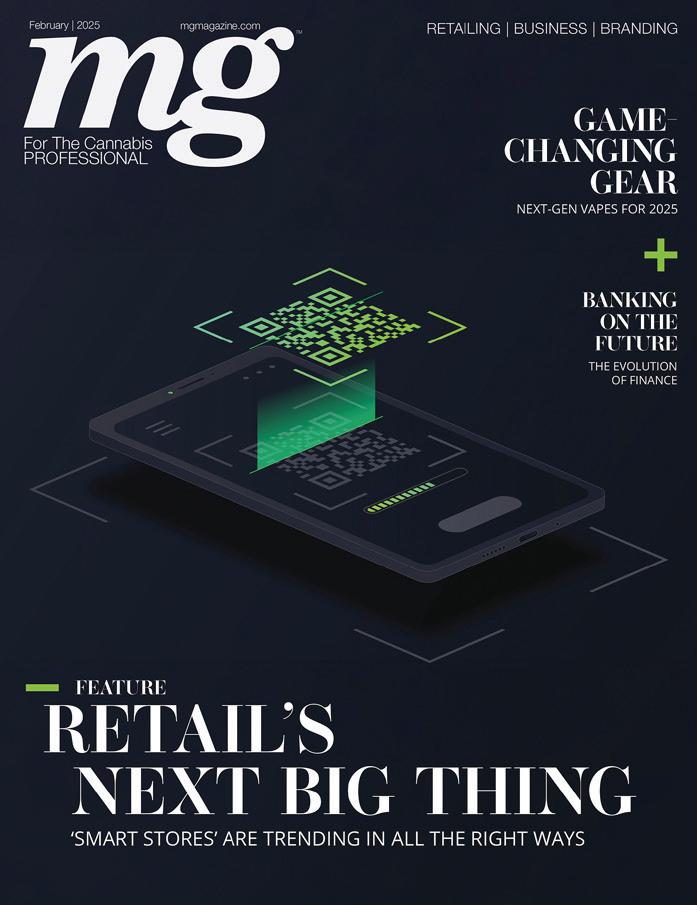

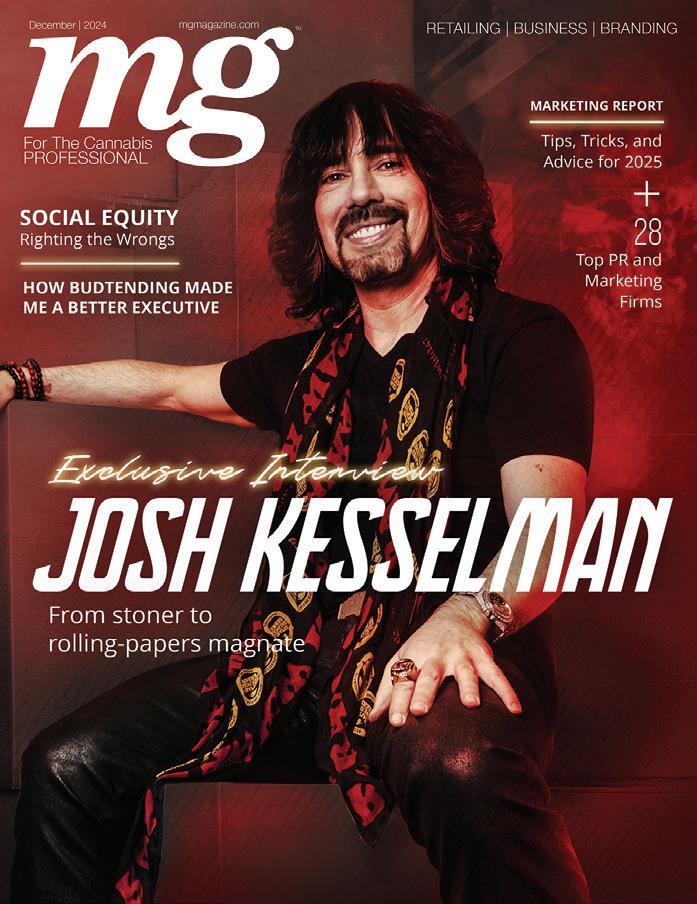










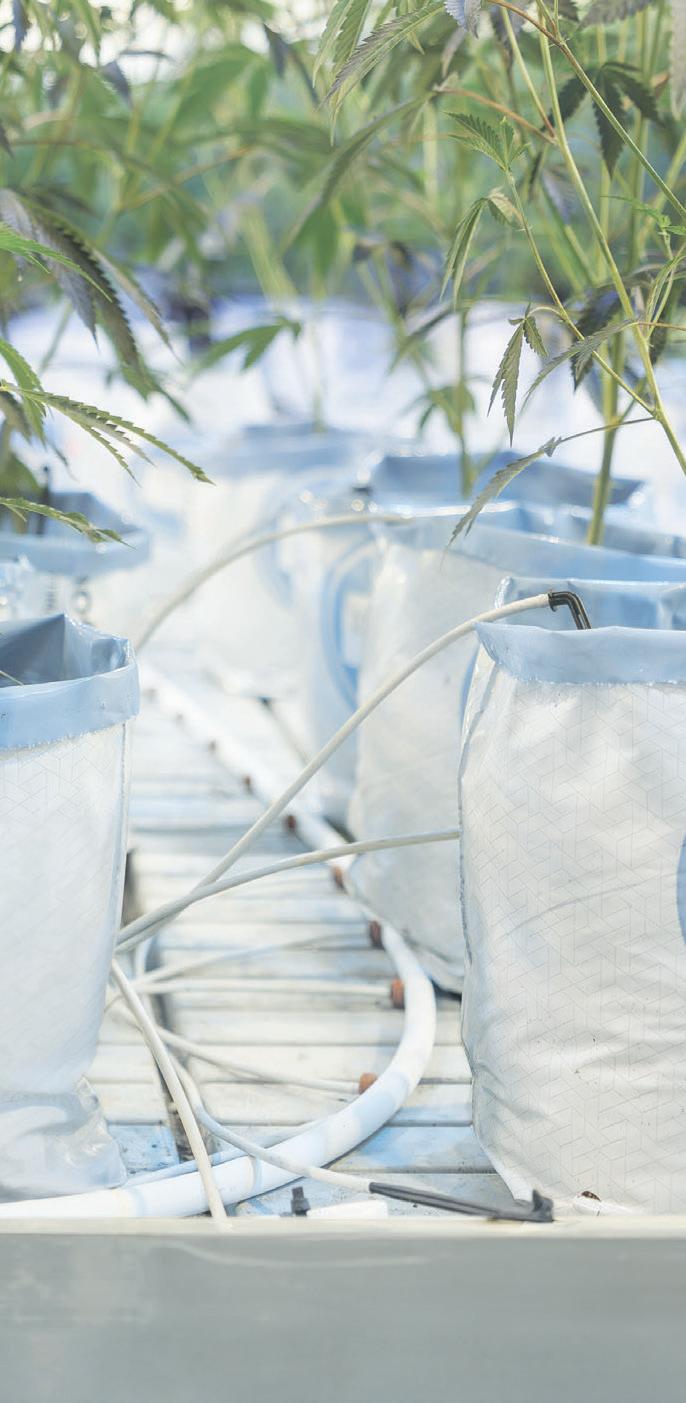



JOIN THE WAITLIST NOW





Introducing SB1 (Sensi Boost 1) — Advanced Nutrients’ 8th-Generation Breakthrough Brix, Resin & Terpene
Enhancer
Supercharge your grow with SB1 for massive, sugar-coated, resin-saturated buds exploding with flavor and aroma.
After 25+ years of research, we’ve cracked the code on crafting the sweetest, gooiest, most terpene-rich flower possible.
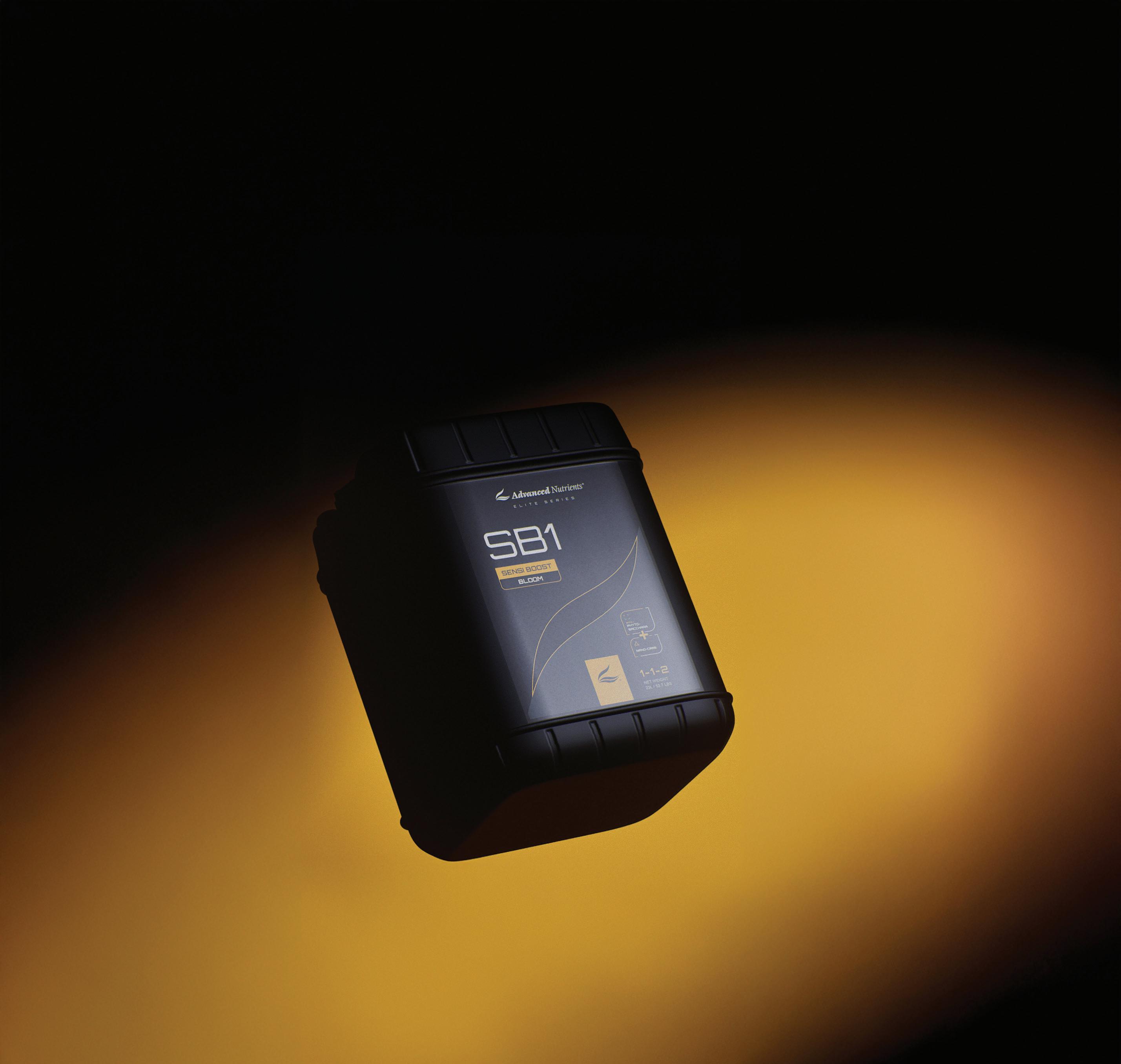
: Breakthrough nanotechnology enables direct sugar uptake, maximizing unsurpassed resin production and terpene enhancement. Unlike conventional products with oversized sugar molecules that only feed substrate microbes, NanoCarb’s nanosized carbohydrates are absorbed directly into your plants, fueling rapid growth, significantly enriching flavor profiles, and
: Advanced Nutrients’ exclusive compound derived from fermented sugarcane extracts. This powerful biostimulant unlocks your flower’s flavor, quality, and bag appeal like nothing else on
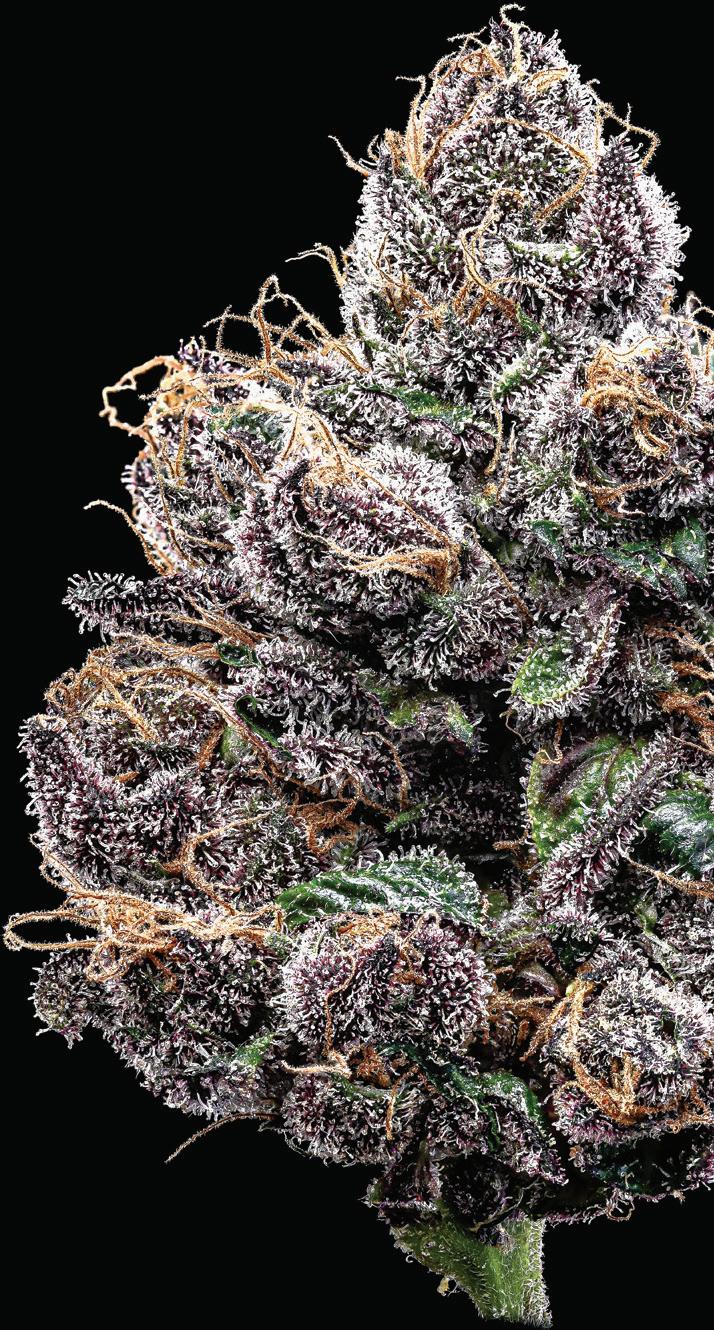





And like all Advanced Nutrients products, it comes with our

With over 25 years of science-backed innovation, Advanced Nutrients delivers solutions that growers in over 120 countries maximize crop value. Don’t waste your time and money on subpar carbohydrates your plants can’t absorb. Harness SB1’s cutting-edge technology and experience heavier harvests of the frostiest, most mouthwatering flower you’ve ever produced.
















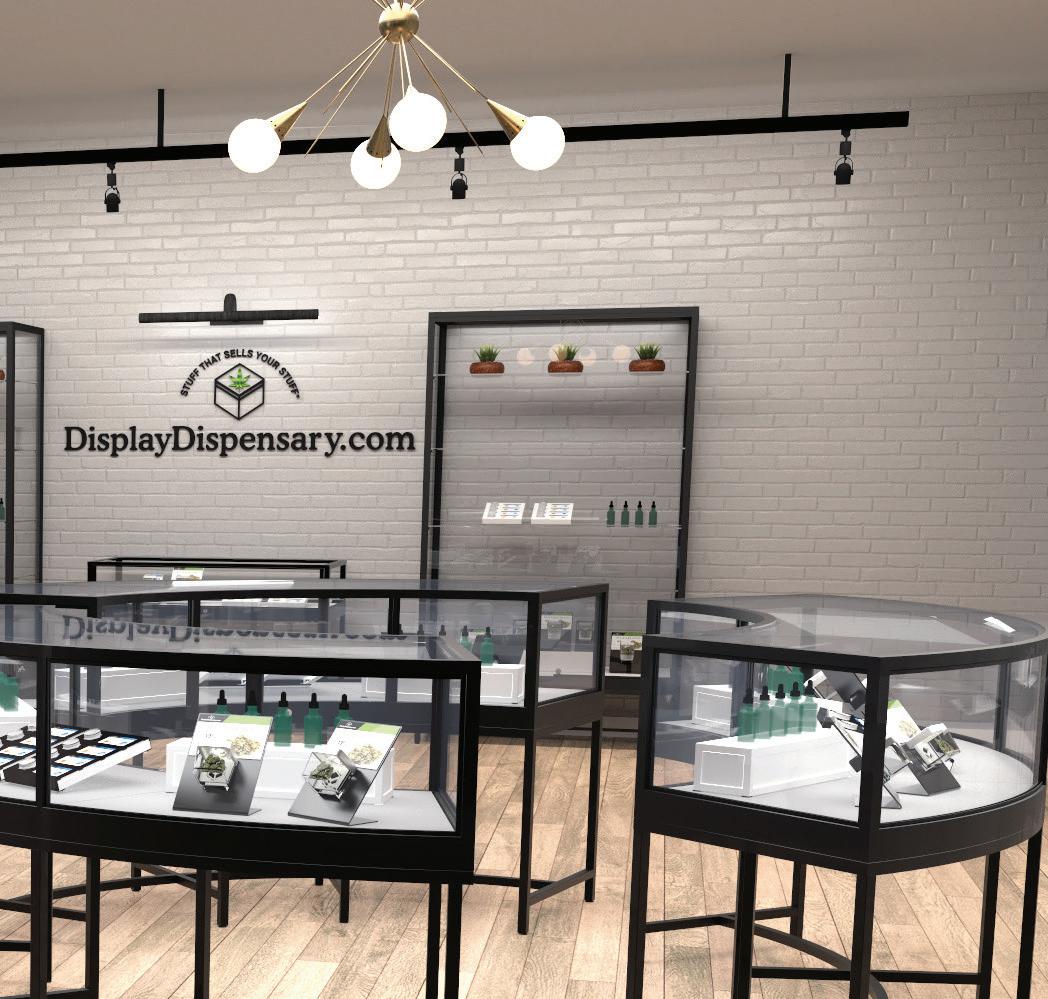
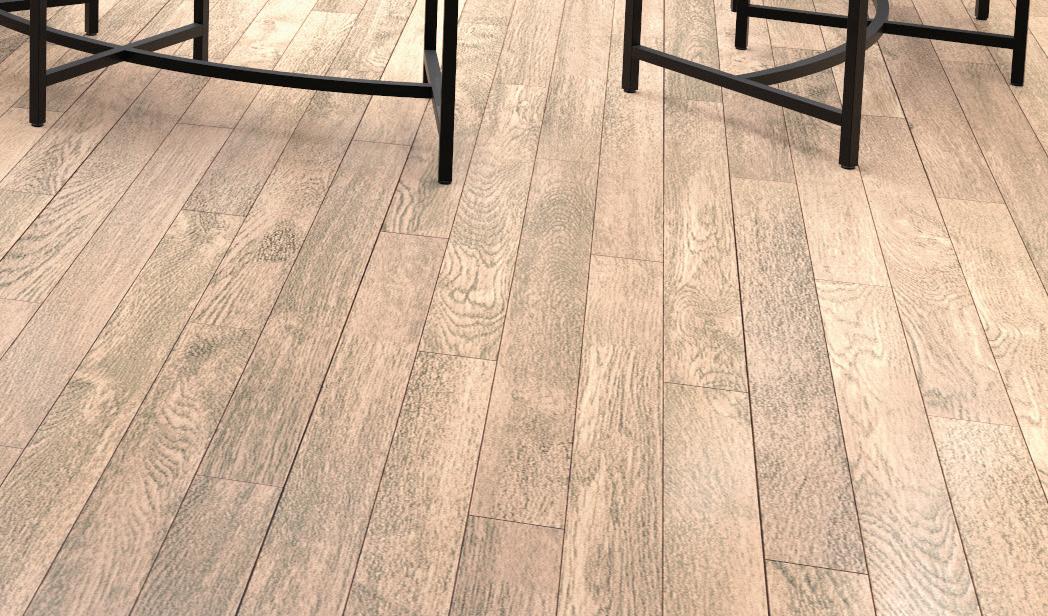




THE NEWSROOM
News, data, trends, forecasts, and other tidbits for the well-informed professional.
Apple’s customer-first philosophy showed one entrepreneur how to build better consumer product brands.
Little Beach Harvest leaned into Shinnecock cultural heritage to create an elevated shopping experience.
Arizona entrepreneur Marie Saloum is building businesses—and a legacy— through empathy and action. Passion and belief in people and the plant informed her inspiring journey from patient advocate to retail innovator.
These developing trends are helping growers improve yields, efficiency, and environmental sustainability.
making an impact.
Despite its modest size, Puffin is a visually enchanting shop with a feelgood vibe. The designers explain the strategies they used to enhance space and play up the store’s vibrant, funloving personality. SOCIAL
Dispensaries can take cues from traditional retail to boost form, function, and flow. From big-box stores to boutique jewelers, museum shops, and even grocery chains, these proven design strategies are key to increasing sales and enhancing the customer experience.
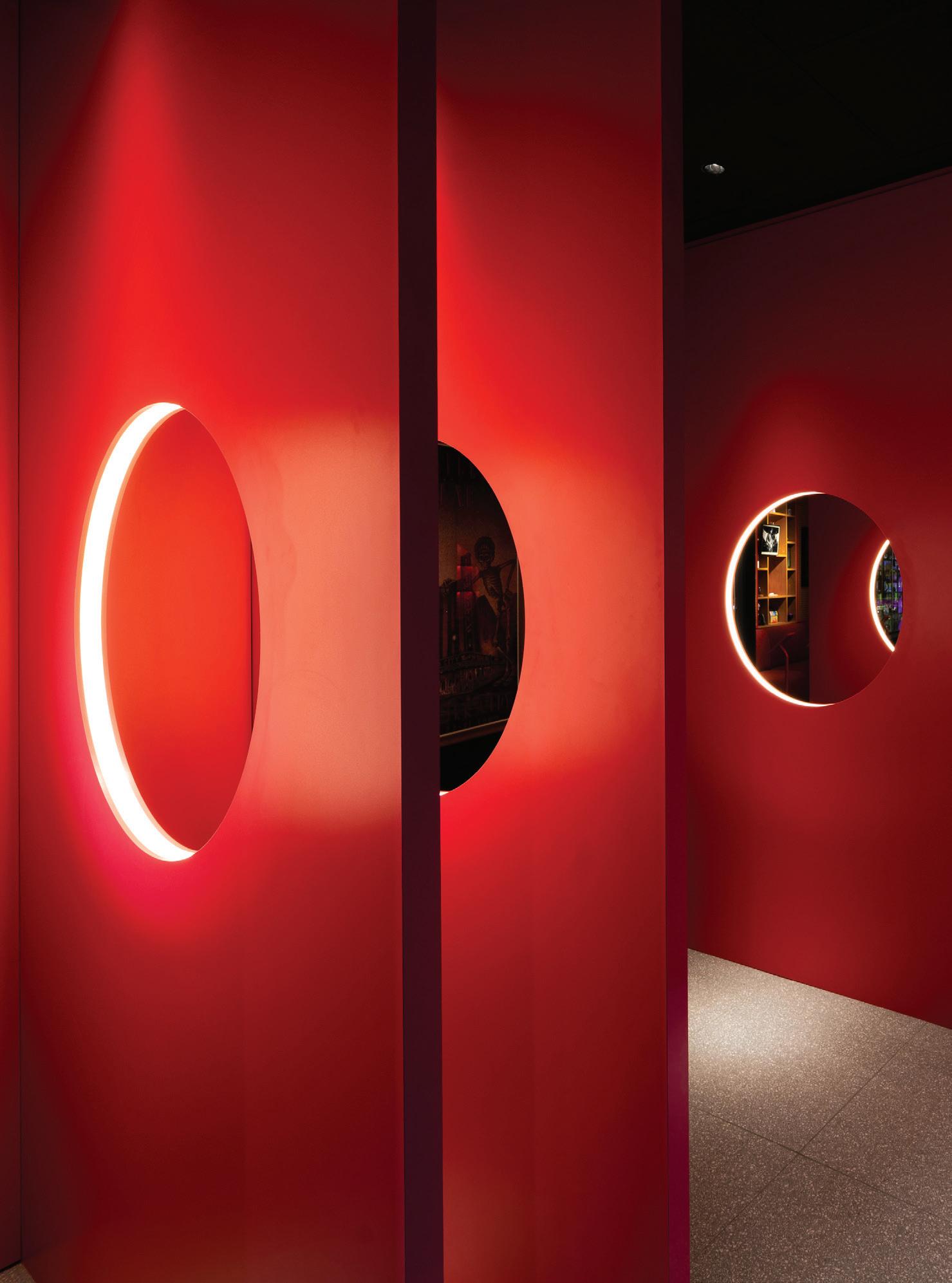

As founder and CEO of CannaPlanners, Will Read brings a no-nonsense approach to disrupting the industry. His background is as dynamic as his leadership style, spanning music, tech, and entrepreneurship. After sharpening his business-development skills at Apple, he launched CannaPlanners in 2016 to normalize cannabis through bold design and next-level digital marketing. CannaPlanners.com

A seasoned professional with more than sixteen years of experience in cultivation, Allison Zervopoulos is known for optimizing practices, maximizing yields, and ensuring top-tier product quality. In roles ranging from large-scale cultivation management to strategic consultancy, she has guided startups and established businesses to sustainable growth. Aliponics.com
—SHIMON SHMUELI, INVENTOR, BUSINESSMAN, PROFESSOR
Cannabis may not be federally legal, but dispensaries increasingly are accepted as mainstream retail operations. In part, that’s because their designs have changed dramatically over the past decade.
In 2015, many dispensaries were small and vaguely headshop-y. As competition increased, so did the size and sophistication of the buildings. Interiors became more luxe, budtenders became sales professionals, and shoppers enjoyed a whole new level of instore experience.
Today, no new dispensary gets off the ground without offering consumers a shopping atmosphere that feels both familiar and intriguingly different. From the opulent and elegant to the understated and cozy, the vast majority of dispensaries offer mainstream perks like loyalty programs and e-commerce, along with teams of well-trained, educated budtenders who provide as little or as much assistance as customers prefer. Some stores take the experience even further with attached consumption lounges, drive-thru windows, art galleries, or themed entertainment that doubles as Instagram-ready promotional props.
As Michele Meyer points out in this month’s feature, the “next wave” in dispensary design may be more like a ripple as shops assimilate even further into the traditional retail landscape. The designers she spoke with recommended repurposing mainstream trends with subtle adaptations to meet cannabis-retail-specific needs. In the executive profile, Arizona entrepreneur Marie Saloum reveals how “mainstreaming” one of her stores led to an impressive bump in sales. And Macey Wolfer explores how the Shinnecock Nation in New York combined current retail design trends with tribal traditions to create a unique dispensary that honors the past while moving steadfastly toward the future.
Retail, like everything else, evolves. Because our industry is so good at rapid evolution, in the not-too-distant future traditional retail may the one playing follow the leader, adapting successful strategies dispensaries pioneered.


Kathee Brewer Editorial Director






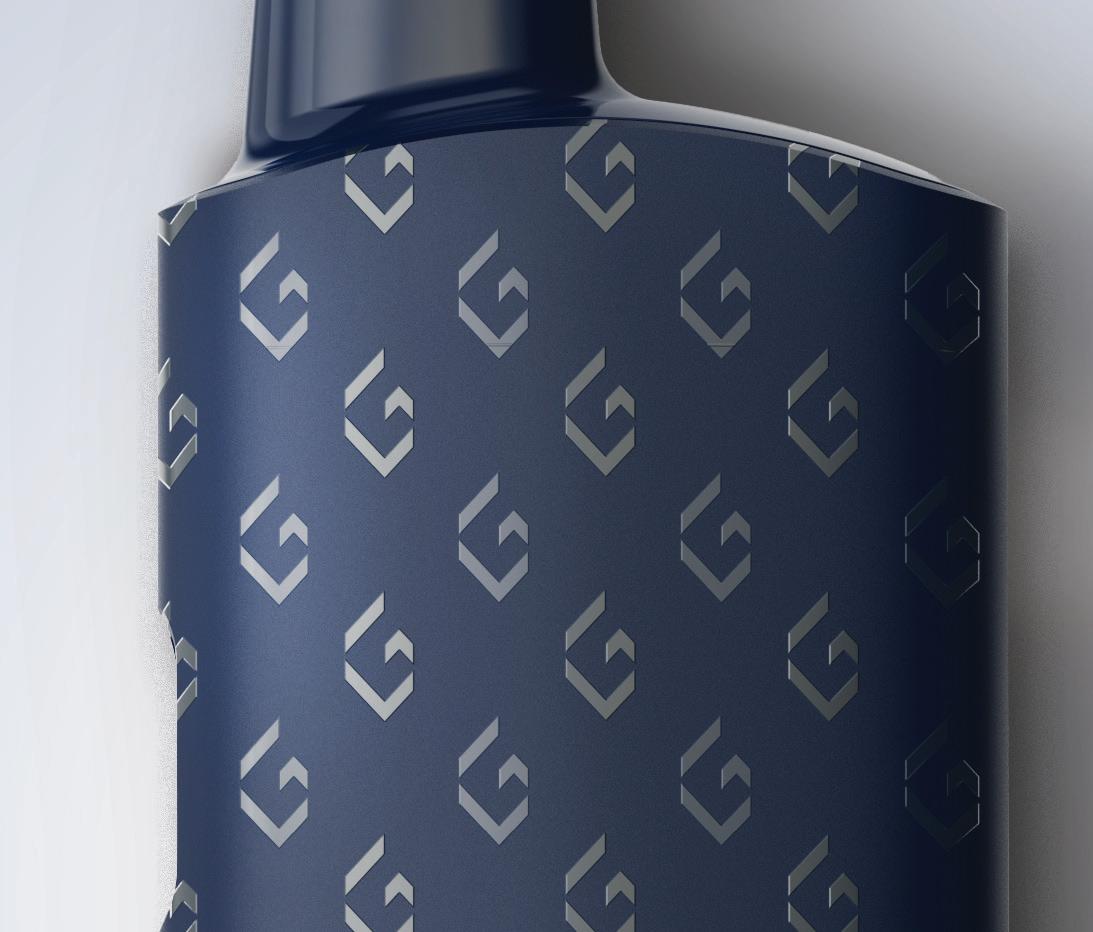
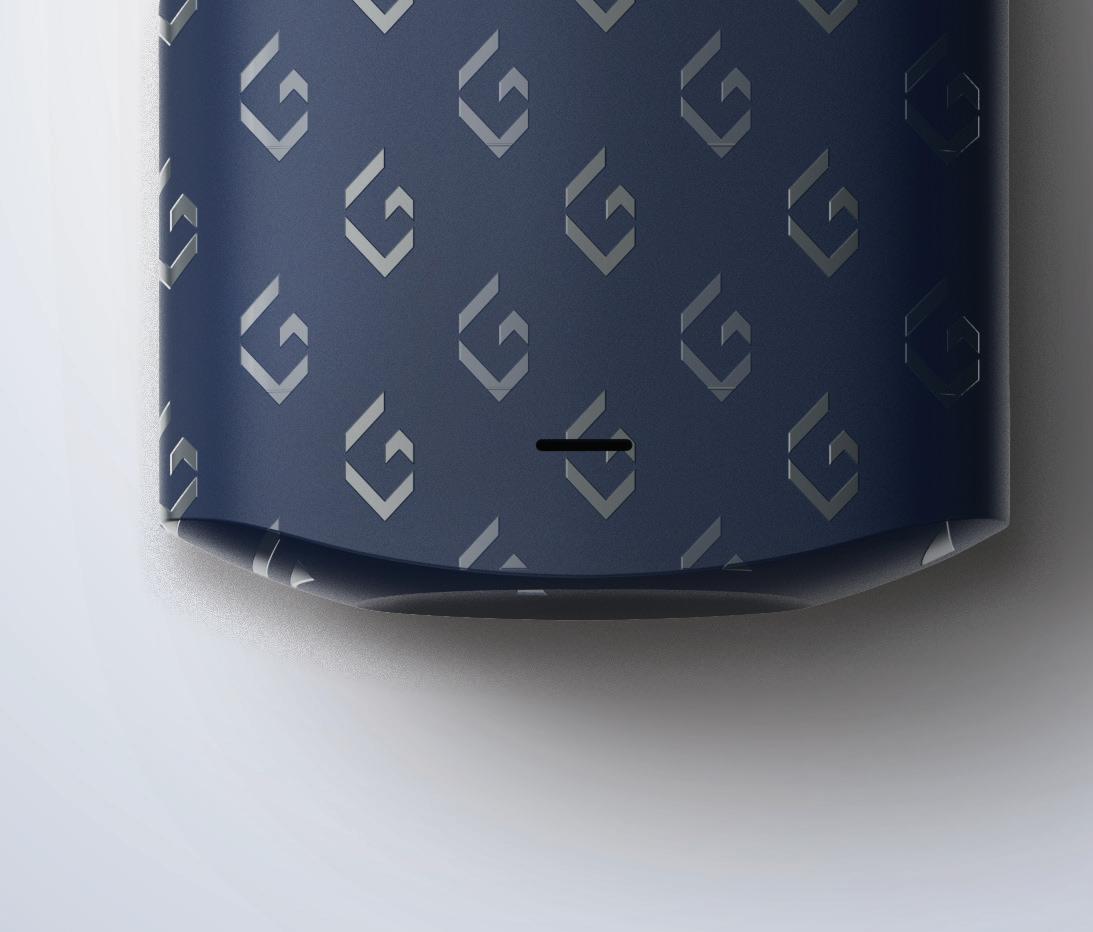


















Editorial Director Kathee Brewer editorial@inc-media.com
Creative Director Angela Derasmo
Digital Strategist Dexter Nelson
Circulation Manager Faith Roberts
Contributing Writers Allison Zervopoulos, Alyson Jaen Esq., Anthony Coniglio, Brendan McKee, Chris O’Ferrell, Christopher Jones, Danny Reed, David Kooi, David Sandelman, Jay Virdi, Justin M. Brandt Esq., Kevin Hart, Kim Prince, Kris Krane, Lance C. Lambert, Laura A. Bianchi Esq., Leah Eisenberg Esq., Luca Boldrini, Marc Beginin Esq., Michael Mejer, Mitchel Chargo Esq., Rachel Gillette Esq., Ricardo Baca, Richard Proud, Robert T. Hoban Esq., Ruth Rauls Esq., Ryan Hurley Esq., Scott Thomas, Shane Johnson MD, Shawna Seldon McGregor, Stacy Litke, Sue Dehnam, Sundie Seefried, Tara Coomans, Taylor Engle, Will Read
Artists/Photographers Carl Schultz, Derlis A Chavarria, Josh Sep, Mike Rosati, Christine Bishop
ADVERTISING SALES & CLIENT SERVICES
BRANDI MESTA
Senior Account Executive
Brandi@inc-media.com (424) 703-3198
BUSINESS OFFICES
Chief Executive Darren Roberts
Tech Architect Travis Abeyta
Accounting
Diane Sarmiento
Brittany Gambrell
Subscriptions subscribe.mgmagazine.com
Back Issues store.mgmagazine.com
Mailing Address
mg Magazine
23055 Sherman Way, Box 5069 West Hills, CA 91308 (310) 421-1860 hello@inc-media.com
MEG CASHEL
Account Manager
Meg@inc-media.com (424) 246-8912
mg Magazine: For The Cannabis Professional Vol.11, No.4 (ISSN 2379-1659) is published monthly by Incunabulum LLC, located at 23055 Sherman Way, No. 5069, West Hills CA 91308. Periodicals Postage Paid at Las Vegas Post O ce and additional mailing locations. POSTMASTER: Send all UAA to CFS. NON-POSTAL AND MILITARY FACILITIES: Send address corrections to mg Magazine, 23055 Sherman Way, No. 5069, West Hills CA 91308.
mg is printed in the USA and all rights are reserved. © 2025 by Incunabulum LLC. mg considers its sources reliable and verifies as much data as possible, although reporting inaccuracies can occur; consequently, readers using this information do so at their own risk. Each business opportunity and/or investment inherently contains criteria understanding that the publisher is not rendering legal or financial advice. Neither Incunabulum LLC nor its employees accept any responsibility whatsoever for contributors’ activities or content provided. All letters sent to mg Magazine will be treated as unconditionally assigned for publication, copyright purposes, and use in any publication or brochure and are subject to mg’s unrestricted right to edit and comment.
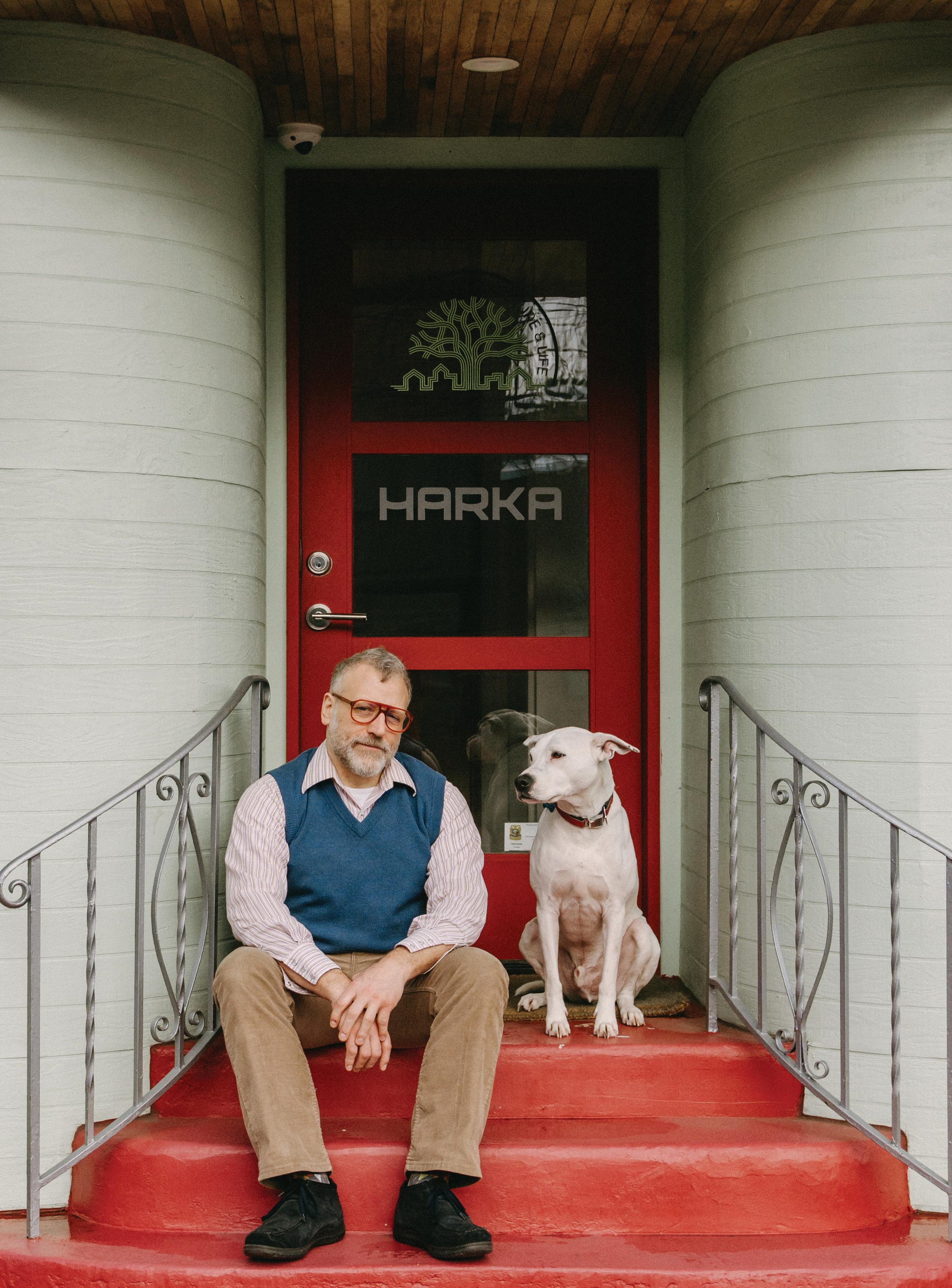
Disposable
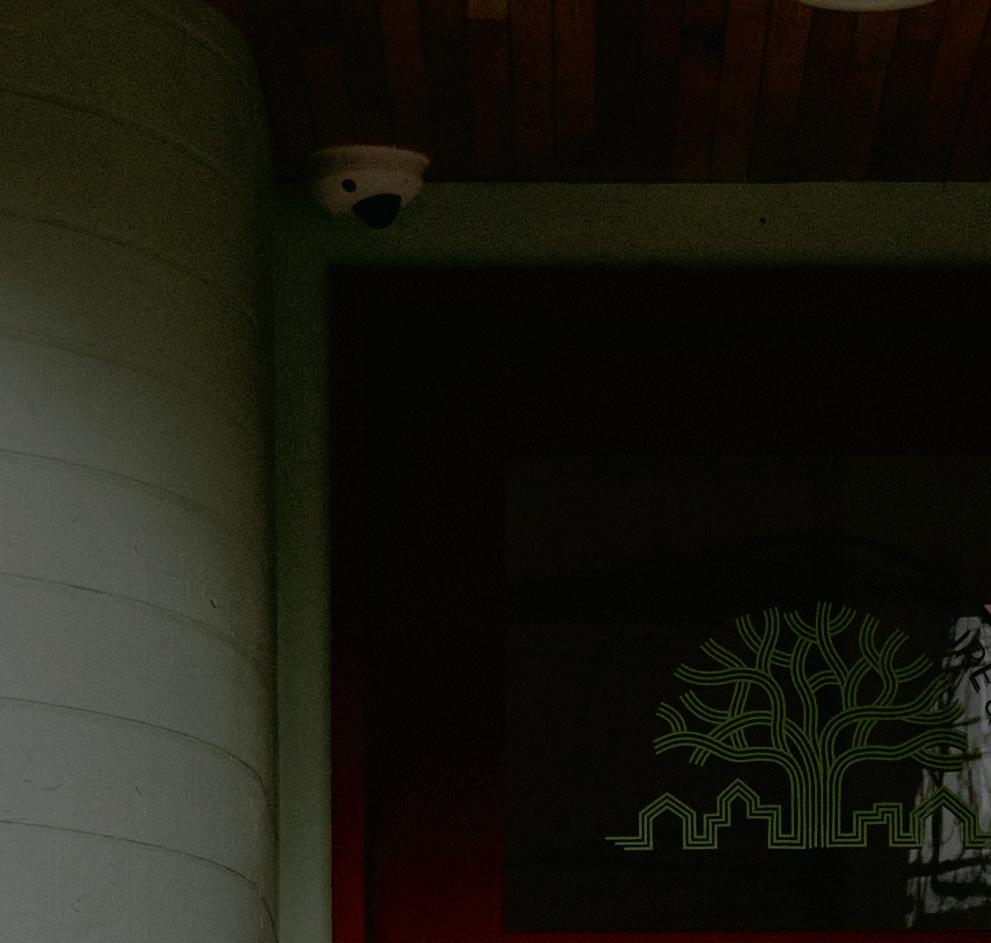
architecture is just like disposable fashion. Rather than change the entire set, just change the props on it.
— Patrick Donaldson, principal architect, Harka Architecture
“ “



ATLANTA – The company that rules the market in fruit bouquets has branched into a wholly different kind of deliverable treat. Edible Brands, the parent company of Edible Arrangements®, launched e-commerce marketplace Edibles.com March 20. The platform offers a curated selection of consumables infused with hempderived THC and other cannabinoids.
Helmed by industry veteran Thomas Winstanley, who serves as executive vice president, the platform launched in Texas. Florida, Georgia, and other southeastern states are expected to follow “rapidly,” along with nationwide shipping to markets where intoxicating hemp is legal.
The company also has leased brick-and-mortar retail space in one of Atlanta’s best-known foodie havens, Inman Park. The location will serve as a prototype for a limited franchising program designed to “democratize access to the THC industry,” according to a prepared statement from Edible Brands.
“The hemp industry is evolving rapidly, but consumers still face challenges with perception, education, and accessibility,” said Chief Executive Officer Somia Farid Silber. “We’re making it easier than ever for consumers to access premium, vetted products with the convenience they expect today.”
Merle Haggard may have dissed marijuana in his country classic “Okie from Muskogee,” but recent studies indicate, despite its traditional association with conservative values, country music mentions drugs more often than any other genre, including rap. What’s more, today’s country artists are as liable to mention cannabis or one of its many euphemisms as alcohol, according to Texas Standard
Powered by
Wholesale platform LeafLink expects six state markets to contribute more than 75 percent of sales growth in the United States over the next three years. Combined, Illinois, Maryland, Minnesota, New Jersey, New York, and Ohio are projected to add 5,000 new dispensary locations and contribute about $6.5 billion of the total $8.5 billion in retail sales growth through 2027.
Leverage AI recommendations to Boost Basket Size this 420
Cannabis retailers can signi cantly boost online sales this 4/20 with AI-powered product recommendations on their e-commerce menu. Nearly 30% of online orders include AI-recommended products, showcasing the e ectiveness of personalized suggestions.
Even more compelling, these orders have a 42% higher average order value, highlighting the revenue potential of tailored recommendations.
Recommendations:
Ask your e-commerce provider if they o er AI product recommendations and make it a focal point on your online menu to maximize upselling for 4/20.
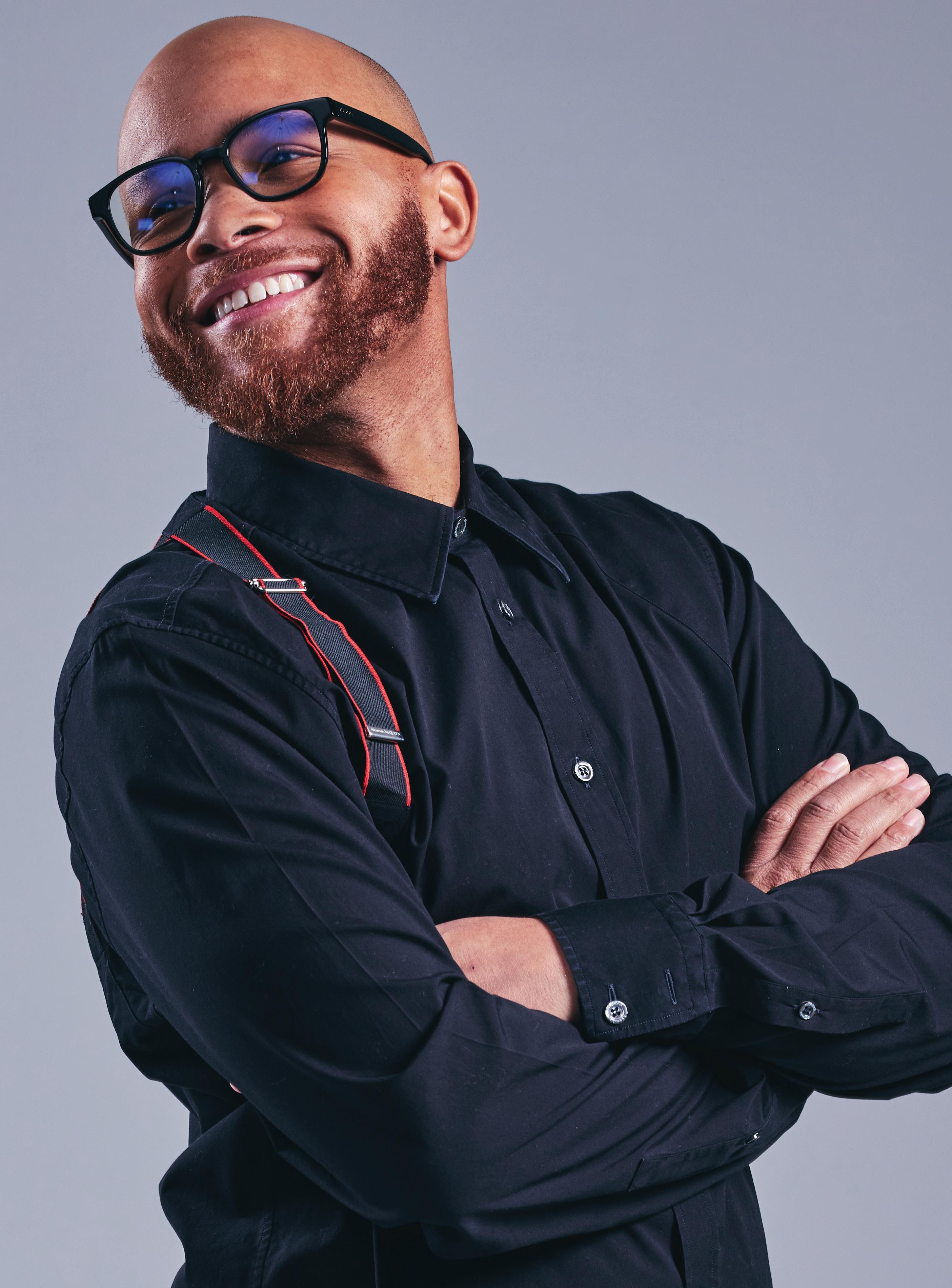
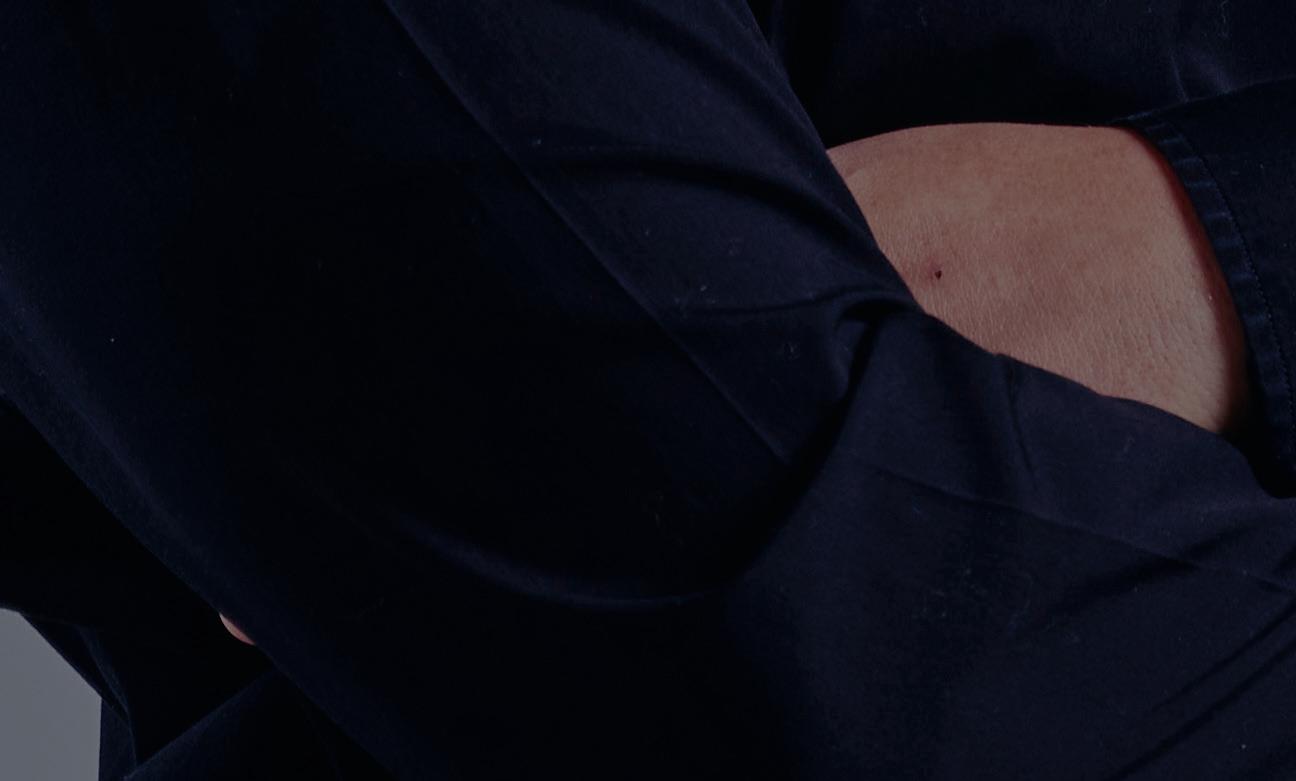
To win in the cannabis space, retailers have to package their brand so value outweighs price.
— Wil Walker, president, Display Dispensary
“ “
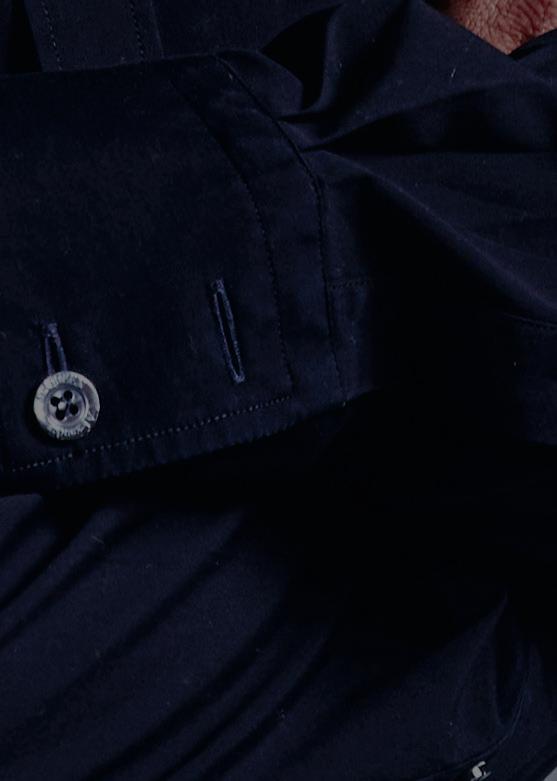
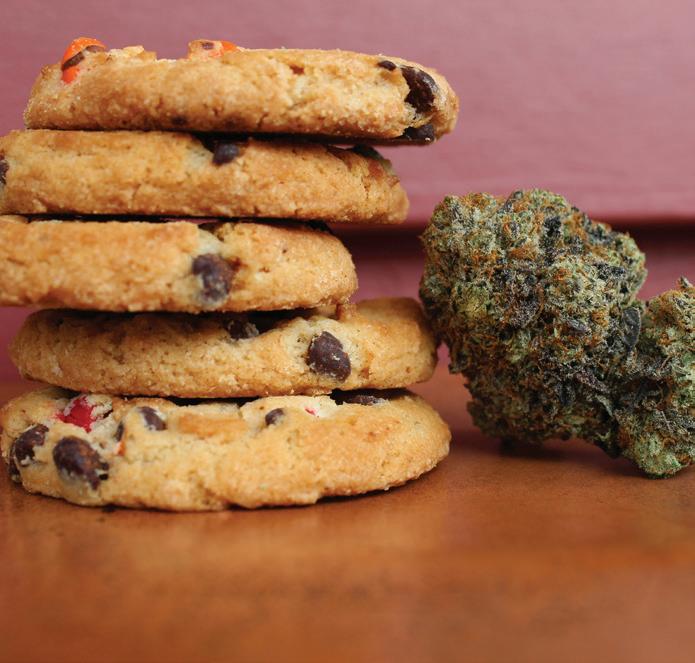
An Illinois blood bank and Lyfe Dispensary teamed up to alleviate the local blood shortage by offering free cannabis in return for donations. Those who volunteered to “Bleed for Weed” received a voucher for an eighth of flower or an edible.
Photo: Margo Amala / Unsplash
Bud & Mary’s TheMyx dissolves seamlessly into any beverage or food without altering taste, texture, or carbonation for a discreet, controlled, and mess-free alternative to traditional product formats. Packaged in a childresistant box, the slim, single-dose packets easily fit into a wallet or purse for a measured dose anytime, anywhere. mixanything.com


A first-of-its-kind study at the University of Arizona discovered administering four terpenes extracted from cannabis— geraniol, linalool, β-caryophyllene, and α-humulene—led to significant reductions in chronic and post-operative pain in mice. The researchers hope to expand their research to treating fibromyalgia in humans.
“

Founded on the profound connection between cannabis culture and art, ZZZ’s Collective reimagined smoking accessories as a canvas for artistic expression and creative collaboration. The limited-edition wraps, designed by twenty-five emerging artists who work in a variety of media, are crafted of premium, unbleached organic hemp paper. zzzs.art
—Mike Wilson, Temeka Group


• Where the cannabis industry’s top professionals connect, innovate, and drive success
• Unparalleled conference programming featuring top industry experts
• Exclusive networking with key players from across the cannabis supply chain
• A cutting-edge expo floor showcasing the latest innovations & solutions
• Iconic networking parties & pre-show workshops


BY WILL READ
I WORKED WITH STEVE JOBS. Well, not really. I worked at Apple while Jobs was still the chief executive, right around the time the first iPad hit shelves and we were all fascinated with the beerdrinking simulator app and the Paper Toss game.
Working in sales at Apple in the early 2000s meant I got a crash course on how to develop an iconic brand and sell products in a way that generates lifelong customers, all while wearing baggy jeans.
Prior to working at Apple, I had a misguided view of sales. I thought all salespeople needed to upsell the most expensive item in the store. Turns out, Apple had a different playbook. The goal wasn’t to sell the priciest gadget; it was to sell the right gadget.
Often a customer would walk in and say, “Give me the biggest, baddest desktop you have.” But Apple taught sales reps to slow down the process and ask questions. What do you do? How are
you planning to use this machine? Why do you think you need so much hard drive space or RAM? By the end of the conversation, it usually became clear the customer needed something way cheaper than what they initially expected.
If all someone needed was a machine to check email and watch YouTube, I wasn’t going to convince them they needed a NASA-level supercomputer. And guess what? That approach built trust. People would come back and ask for me by name. They weren’t just customers at that point. They had become loyal fans of the brand.
Apple’s philosophy stuck with me as I advanced in my career and started my own marketing and branding agency for cannabis businesses. I know a one-time sale means little if the customer doesn’t buy from you ever again. Great brands aren’t built on aggressive sales tactics. They’re built on relationships.

If you walk into a dispensary today, odds are the vibe is either sleek and minimalist with glass and wood (like an Apple Store) or crammed with mismatched displays like a convenience store. It’s obvious brands have taken cues from the tech world, but the industry is still young and many businesses are figuring things out as they go.
This is where the Apple mindset comes into play. Branding is more than just a cool logo; it’s about creating an experience. At Apple, every product, every box, every store was meticulously designed to reflect the brand’s essence. Cannabis brands need that same intentionality—not just so they look good but also so they build trust, loyalty, and long-term success.
Of course, not everyone is looking for the sleek, white-box aesthetic. Some brands embrace neon, pot leaves, and
classic stoner culture. And that’s fine. Great branding isn’t about forcing one style. Instead, great branding involves understanding your audience and telling your story in a way that resonates.
At its heart, great branding is about creating experiences, emotions, and even cultural moments. Remember when Apple released the first iPhone? That moment marked a cultural shift that shaped not only the mobile phone industry but also our daily lives.
Sure, good design and marketing are crucial, but they can take a brand only so far. Authenticity and innovation are what make brands stand out and build trust. Apple is iconic because the products and the people selling them are reliable. Diehard Apple users are on their fourteenth iPhone. We keep buying the next generation because we trust the new model is going to mesh with our lifestyles and workplace needs.
So, what’s the secret sauce? Killer design, trustworthy branding, and a customer experience that makes people feel like they’re part of something bigger are all essential components of Apple’s success. Cannabis brands need those same ingredients—because at the end of the day cannabis, like Apple, is more than just a collection of products. It’s a movement. The brands that embrace that truth will last.
Brands that attain icon status evoke a feeling or lifestyle. Sure, there are plenty of notable cannabis companies, but far fewer truly memorable brands. Cookies, Stiiizy, and a handful of others come to mind, but there is no cannabis brand with the significance of a Nike or Apple. Currently, there’s no individual cannabis brand that defines the culture at a mainstream level.
Until federal legalization opens the floodgates, we’re stuck in a fragmented market where most companies are forced to think locally rather than nationally. But that doesn’t mean they can’t build something iconic.
Branding is a balancing act. On one hand, regulation threatens to squeeze the creativity out of the industry, forcing companies into compliance-first, personality-second branding. On the other hand, trends evolve. Like fashion, branding is cyclical, and the cannabis brands that thrive will be the ones that adapt without losing their core identity.
But the real key to longevity?
Authenticity. The great brands—the ones that will stand the test of time—are the ones that build real connections with their customers. And when the first true “Apple of cannabis” emerges, you can bet it’ll be a brand that understands this at its core.
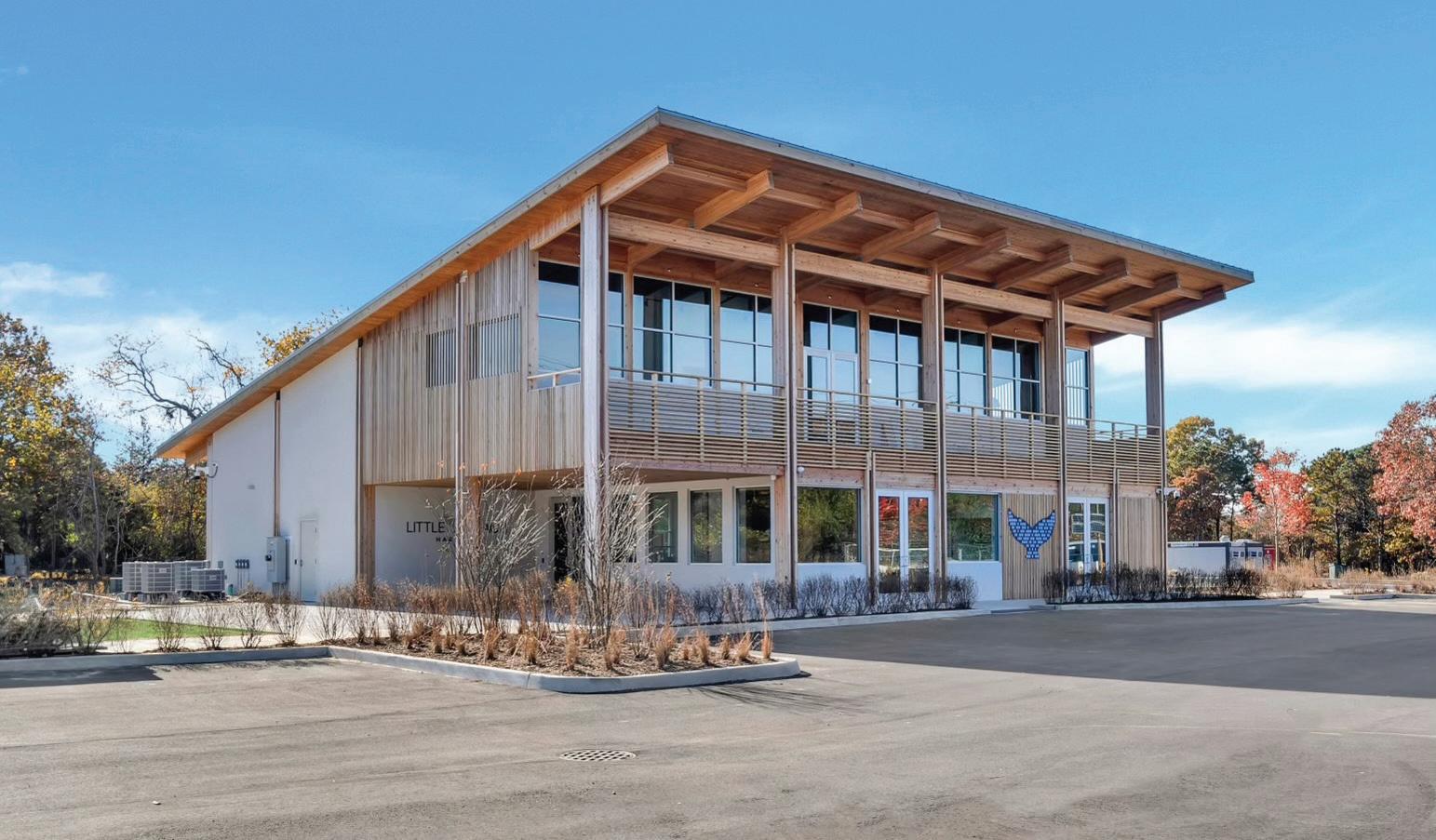
Owned and operated by the Shinnecock Nation, the New York dispensary embodies the proud heritage and resilience of a people as they engineer a new future of their own choosing.
BY MACEY WOLFER
PHOTOGRAPHY BY DERLIS A CHAVARRIA

The Shinnecock Nation is one of the oldest self-governing tribes in New York state, so it’s only fitting the people became the first to operate a tribal-owned dispensary in the Eastern Long Island region. Opened in 2023 and licensed by the Shinnecock Cannabis Regulatory Division, vertically integrated Little Beach Harvest is a testament to the resilience of the Shinnecock Nation and its members. The dispensary’s spatial design and organic aesthetics are a reflection of the tribe’s values and culture.
Characterized by wood cladding and large glass windows, the building encompasses about 6,000 square feet and boasts a bright, natural, and comfortable atmosphere. The large woodframed structure features a sloped, shed-type roof that imbues the building with a modern vibe and maximizes the natural light entering the building.
The interior, also lined with light-colored raw wood, is decorated with beadworks, jewelry, and a collage of images photographed by tribal members.
The photos depict a wide variety of valuable plant medicine found in the local area, from cedar and sage to cannabis.
The images display “all the things that encompass what we’ve used traditionally as medicine here,” said Sean Boyd, a Shinnecock tribal member and brand specialist for the store.
While the cultural and traditional-medicine tidbits are integral to the dispensary’s big picture, they’re not the main focus.
“At the end of the day, we are selling medicine— cannabis—more than we are selling our culture,” Boyd said. “We are a business, and our business isn’t to sell our culture. It’s to offer plant medicine and provide an experience. But we also want to remind visitors of where they are and the space they’re stepping into.”
Located on tribal land in the present-day Hamptons, the store enjoys significant traffic during the spring and summer months when vacationers are abundant; traffic slows down during the offseason. Regardless of the time of year, though,
the dispensary’s design reflects a “Hamptons summertime” aesthetic with its open layout, natural light, extensive space, and airy displays.
The name Shinnecock roughly translates to “people of the stony shore,” hence the natural stone flooring and other design features that elicit a seaside ambiance. Flow is a key aspect of the store’s floor plan, as it reflects the tribe’s ever-evolving nature while also calling out the beachside location.
“We have lots of flowing things, like tall glass display cases,” said Jay Wright, a Shinnecock citizen and product marketing manager for Little Beach Harvest. “We have shells and lots of beach scenery to flow in with everything.”
The dispensary’s massive size stands out from the everyday cannabis-shop experience. Two-story-high
ceilings catch customers’ attention immediately upon entry. Wright explained the team can always tell when it’s a person’s first time visiting, because their gaze travels upward to take in the sheer volume of the space.
“Rays of sun shine through the building for natural lighting,” Wright said. “Everything about this building is natural, because that’s who we are as a people and what we’ve always been accustomed to.”
While the top floor of the building currently is used as an office for the team, work is underway to convert the space into a consumption lounge and events venue. (Little Beach already has hosted several events, from live musical performances to cookouts and art exhibits featuring Shinnecock and Long Island artists.)

"THE BUILDING IS A TESTAMENT TO THE RESILIENCE OF OUR TRIBE.”
—Sean Boyd, brand specialist
In addition to the curated art pieces sprinkled throughout the sales floor, Little Beach also incorporates a twelve-foot mural: a live painting gifted from a local Shinnecock artist and cultivator known as Taboo. Wright and Boyd said visitors regularly ask about the mural, providing an opportunity for the team to support and uplift their community. Taboo’s brand, Peshaun Exotic Flowers, is on the shelves at the store.
“This building has a lot of community involvement inside of it,” said Wright. “We don’t care if guests even end up buying something as long as they leave with a piece of knowledge and understanding about where they are and who’s in their area. That’s what we’re aiming for.”
Boyd and Wright explained the importance of disparate groups bonding over the plant’s vast potential. While the two men are proponents of medicinal use, they also advocate for cannabis bringing people together socially and opening doors for artistic expression and the free-flowing exchange of ideas. The two explained they often push back against the stigma associated with cannabis use, especially among tribal communities. The store’s design plays a crucial role in challenging preconceived notions about what it means to be someone who uses cannabis.
A recent Gallup poll found 15 percent of Americans identify as cannabis smokers, consistent with an overall upward trend in recent years. Despite the plant’s growing acceptance and accessibility, stigma can carry a lot of weight in tribal communities. A key aspect of Little Beach Harvest’s design is the creation of a safe, comfortable space for customers from all walks of life to explore.
“I can’t even tell you how many times people have asked us when we’re going to put up a casino,” Wright said. “The stigma that [indigenous] people just get drunk or gamble—that’s what we’re trying to break down. We can do other things. That’s what this building means to us.”
Little Beach Harvest’s team also was intentional when they created large, open displays that don’t overwhelm or intimidate visitors.
“There isn’t just cannabis everywhere,” Boyd said. “It’s there when you look for it, but it’s not very bold or in your face. Customers come up to our budtenders and ask for knowledge, seek knowledge, and receive
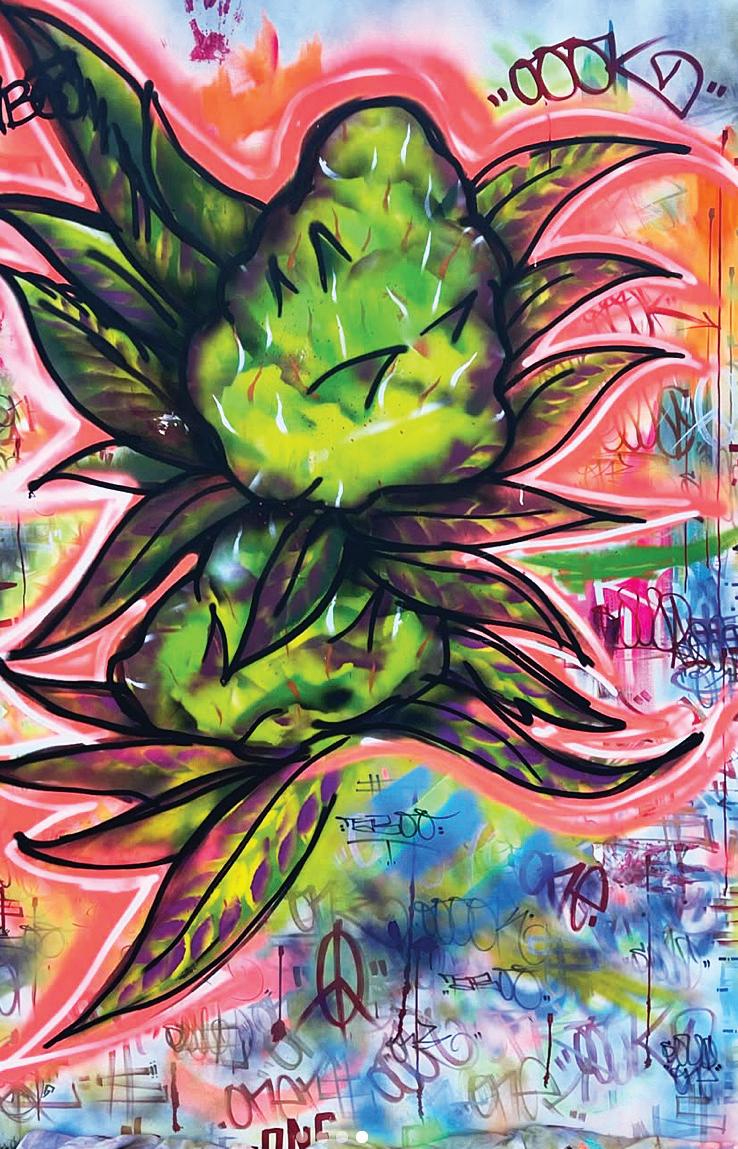
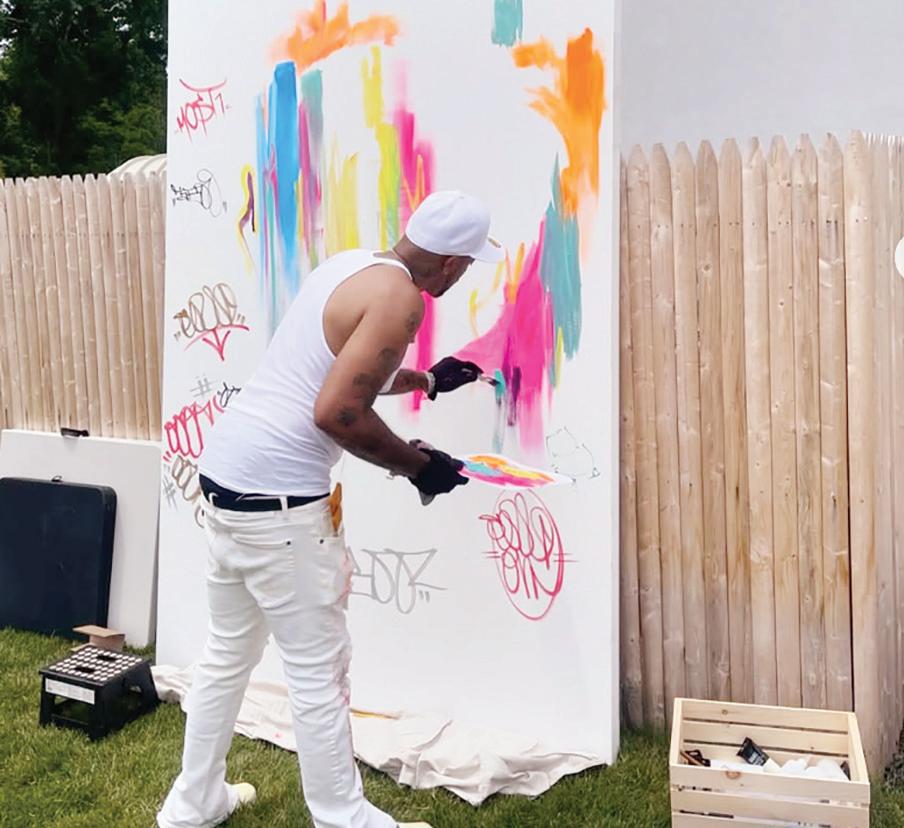
knowledge in a way that’s different from some other dispensary experiences.”
Wright explained many of the dispensary’s customers are either novices or haven’t engaged with the plant for decades. These types of consumers often don’t know where to start on their personal journey.
“Having nice, open, comfortable sceneries and displays that are meaningful to what people are looking for and curated the right way gives people a sense of ease,” Wright said.
While plenty of customers may seek a sense of ease and access to education, Little Beach Harvest also welcomes customers who know exactly what they like and prefer an in-and-out experience. For this demographic, kiosks are a handy tool for quick selection and checkout. For an even quicker experience, customers may also utilize the store’s drive-thru window.
“We have early-morning rushes with people who are on the go and don’t want to get out of the car,” said Wright, adding that such customers may place an order on their phone and pick up their selections at the drive-thru shortly thereafter. “It’s all about keeping it sleek, fresh, and intuitive.”
Keeping things fresh and adapting to needs are recurring themes for the dispensary and the indigenous nation behind it. Both qualities are deeply embedded in the Shinnecock people, who have resided on Long Island for thousands of years. The tribe’s evolution has not been easy, Boyd and Wright admitted, but the tribe is strong and resilient. For the Little Beach Harvest team, the mere existence of the dispensary is a powerful reminder of the people’s vigor.
“The building itself, the whole process of getting this structured and done, is a testament to the resilience of our tribe,” said Boyd. “It’s a testament to staying true to our culture, to preserving what it is to be Shinnecock, which changes over time. It changes in situations. But at the end of the day, who we are— the people—that doesn’t change. That’s what we wanted to establish within this building.”
He explained the Shinnecock people have always been community-centered, so creating a building that serves as a community hub was only natural.
“This project and the idea of us moving forward as a people resonates within this building and within the culture of this company,” Wright said.
The building’s open floor plan also highlights the values of the Shinnecock people. Boyd described his


THE IDEA OF US MOVING FORWARD AS A PEOPLE RESONATES WITHIN THIS BUILDING AND WITHIN THE CULTURE OF THIS COMPANY.”
—Jay Wright, product marketing manager
tribe as “very open and hardworking. The whole idea of the building being open and free flowing was there from the beginning. We are resilient, steadfast, and everchanging and growing. We have been here since the founding of this town.”
Although Boyd and Wright care deeply about their tribal community, they are also dedicated to the larger Southampton and cannabis communities.
“Yes, we are Shinnecock members, but we’re also members of the larger community,” Boyd said. “We went to Southampton High School, and we grew up in this town.”
Consequently, when the Little Beach Harvest team began to develop the dispensary, they sought input from all stakeholders to inform the plan. Setting a structure that reflected sometimes-diverse values was important to the team, as they knew the interior could always change and adapt, but the exterior would be permanent.
“We were blessed with this building, and then we had this freedom where we could curate it on the inside in different ways as we change through the seasons and with our customers,” said Boyd. “We’re fortunate that the building is beautiful and does its job in attracting people here.”
Little Beach Harvest’s strong presence in the community, large building, and open interior design act as powerful symbols and a reminder that the Shinnecock remain a growing, autonomous nation with its own territory and ancestral traditions. Even the building’s location tells a compelling story of resilience.
“Right in front of our building is a foundation of a building that was once an opportunity to encroach on our land, not too long before there was structural and economic development on the front side of the territory,” Boyd said. “Builders wanted to take parts of our land to do what they wanted with it. And it took a group of elder women and the support of the community to go out there and protest, to fight for our land and establish a solid boundary.”
The story almost had been forgotten until development for the dispensary began. When a bulldozer preparing the site for the next chapter in Shinnecock history uncovered the buried remains of the old battleground, it seemed a fitting coda for the attempted betrayal.
“We rediscovered that foundation, and we left it there as a sign and remembrance of what it took us to be able to actually build this and to be here,” Boyd said. “And the fight that our ancestors put up for us. The fight that we continue to take forth to exert our sovereignty.”
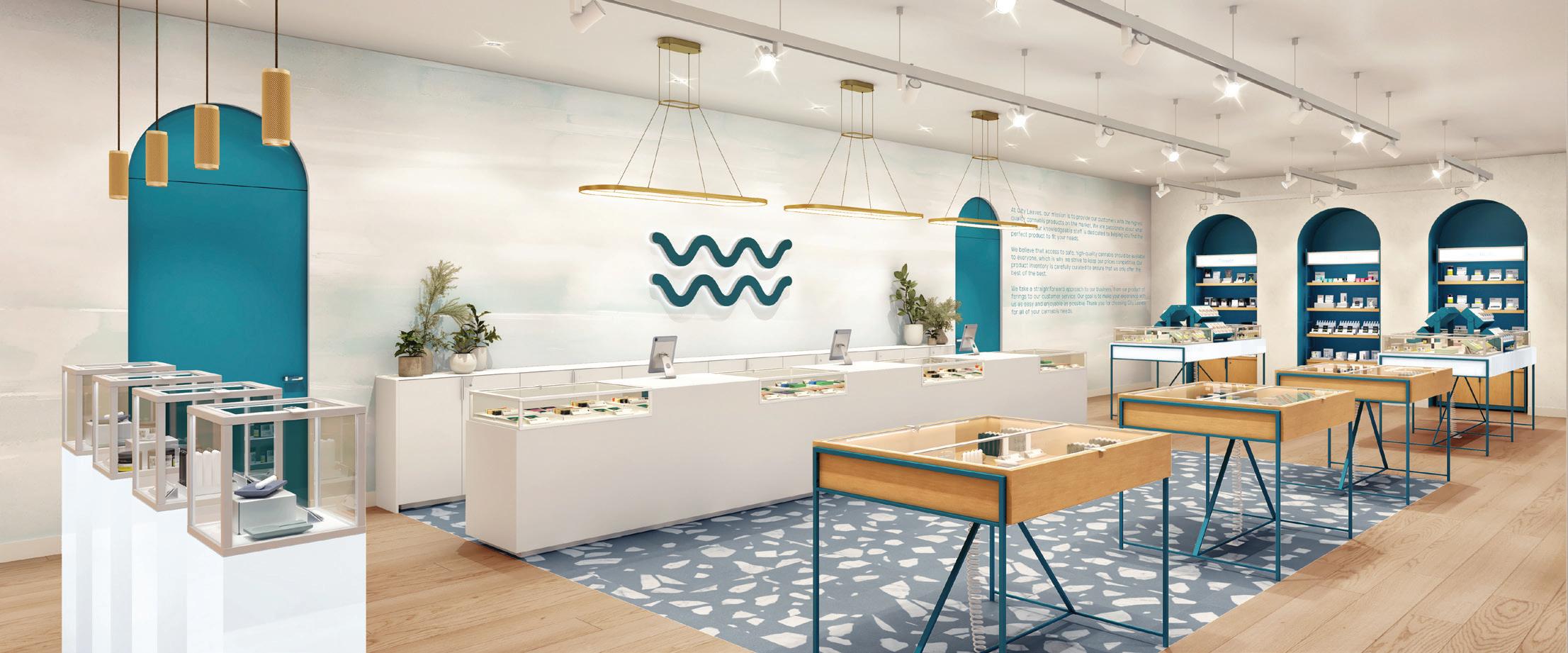
THE COMPANY'S STORYTELLING-BASED DESIGNS ELEVATE RETAIL, REPLACING STIGMA WITH STYLE.
For the past eight years, the Visual Elements design team has pioneered the normalization and elevation of the cannabis retail experience. Part of a renowned retail manufacturing firm with more than thirty years’ experience creating environments for toptier brands like Louis Vuitton, Nordstrom, and Coach, the dispensary team leveraged Visual Elements’ expertise to mold cannabis retail design in a way that negates stigma and encourages innovation.
As Canada’s cannabis industry grew, Visual Elements recognized the need for a dedicated division that could serve the emerging market. So, the firm took its team’s extensive background in high-end fixture and millwork fabrication, noted the unique needs of dispensaries, and set out to create solutions for dispensary owners across North America.
“Because we come from mainstream retail and we have people on our team who actively worked for traditional brands, we came into this with a deep understanding of how retail operates,” said Vice President of Business Development Danielle Marzarella. “That’s what makes our customer service so significant. We already have a really strong idea of how this is supposed to work.”
Unlike many firms that pivot to new industries and don’t look back, Visual Elements remains deeply connected to the world of mainstream retail, and that connection continues to shape the team’s approach to dispensary design. Recently, the firm partnered with Rihanna’s Savage X Fenty to design, engineer, manufacture, and install fixtures for the brand’s shop-in-shop at Selfridges, London. The Visual Elements team also fabricated the Moose Knuckles flagship store and Birks’ fine jewelry boutique at Royalmount Mall in Quebec. High-end mainstream collaborations like these inform Visual
Elements’ work with top retailers inside and outside the cannabis industry. The team has become a trusted resource, particularly for trend-forward operators that target the younger consumers who are shaping the future of retail.
One of the key differentiators is the firm’s vertical integration—a rarity in the design world. While most designers work with unrelated manufacturers to execute their designs, Visual Elements manages everything inhouse, from design development through engineering and manufacturing to installation. The streamlined approach allows the company to design and engineer with production in mind from the first brainstorm.
“It helps bring speed-to-market,” Marzarella said. “Those transitions and phases you have to go through when you have one service provider for one thing and someone else for another—we already have that in-house mindset of how to engineer fixtures so they are commercially viable and production-friendly.”
The meticulous attention to detail for which the firm is known begins on day one. When onboarding a new client, the team conducts an in-depth discovery process, using a detailed questionnaire to gain a thorough understanding of the brand’s identity and competitive positioning.
“We work closely with our clients to identify and define their unique differentiators in the market,” Creative
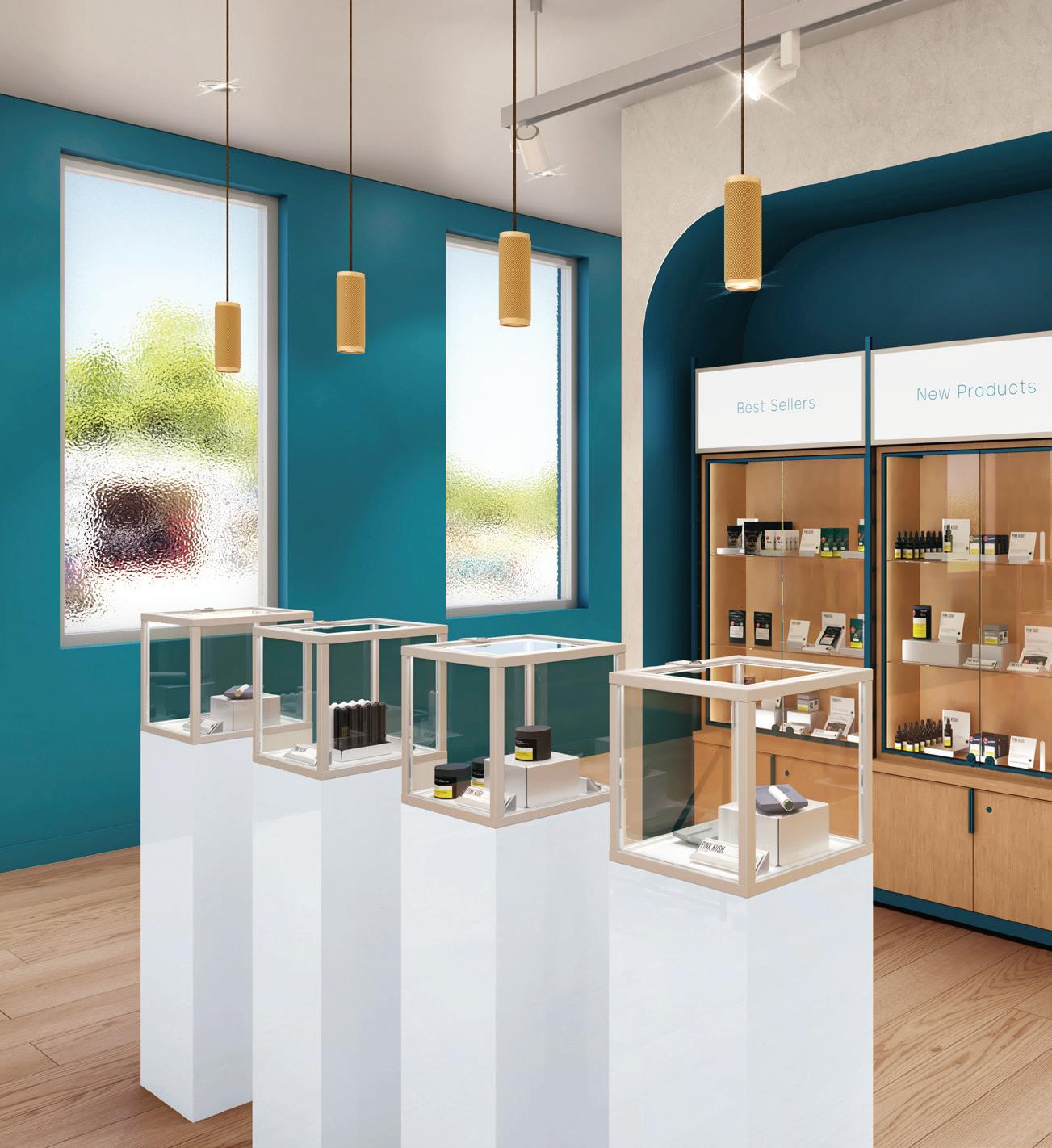
Director Desmond Chan said. “Good design is also a combination of form and function. It balances aesthetics with purpose, ensuring staff efficiency, operational flow, and an unforgettable customer experience. If a store’s design doesn’t function well, it won’t retain customers.”
The team’s immersive, high-end dispensary environments have been featured in numerous mainstream publications, including The New York Times, Hospitality Design, Dwell, Wallpaper*, and Interior Design.
“I think we’ve brought a lot of perspective to the cannabis experience when it comes to design,” Marzarella said. “The designs that Desmond and the team have created resonate with so many people because they emphasize the power of storytelling and the meaningful impact of branding.”
The desire to encourage function and erase stigma enables Visual Elements to create spaces that look and feel unlike any other luxury retail experience. The firm’s approach is not only creative and strategic in navigating cannabis industry regulations, but also has been instrumental in reshaping how cannabis is perceived in the public eye.
“Designing within strict regulations requires a different level of creativity that isn’t always needed in traditional retail,” Chan said. “But based on how Canada has evolved since 2018 [when the country legalized a recreational market], I’m confident these frameworks will continue to adapt. For now, it’s an opportunity to innovate, whether that means designing a decompression zone to elegantly maintain privacy or reimagining the check-in process as an engaging brand touchpoint rather than a routine ID check at the pharmacy.”
Visual Elements’ ability to turn challenges into opportunities has allowed the firm to set new benchmarks for cannabis retail design. By thinking beyond compliance and focusing on experience, the team helps retailers create immersive, welcoming environments that resonate with both seasoned consumers and the newly curious. With a growing list of clients and projects, the team continues to push boundaries, developing adaptable, design-forward solutions that keep cannabis retail on par with the world’s most sophisticated shopping experiences.
“Being on the front line with clients, the best evolution I’ve seen in this space is increased sensitivity and the identification of the importance of the retail experience,” Marzarella said. “I think when we first started, there was little understanding of the significance of the brand and customer perspective. But we’ve come a long way, and we’re excited to see what’s next.” visual-elements.ca
A FIRST-GENERATION AMERICAN OFFERS PERSPECTIVE ON ENTREPRENEURSHIP, THE INDUSTRY, AND LITTLE THINGS THAT MAKE A BIG DIFFERENCE.
BY MACEY WOLFER PHOTOGRAPHY BY CARL SCHULTZ

Growing up in Los Angeles, Marie Saloum was no stranger to the world of recreational cannabis. Even before California voters legalized adult use in 2016, the plant was available everywhere. Her interest in medical applications came later, after her husband was injured in a vehicle-rollover accident.
“They threw him a lot of medication, and you could tell he was getting a little bit addicted,” she said.
Cannabis helped alleviate his pain and wean him away from pharmaceuticals. It’s a common refrain, but Saloum's gratitude became a quest to help others find similar, lifechanging relief. In 2010, her resolve coalesced around launching Marijuana Doctor, a platform connecting Arizona residents with education and a resource for patients seeking medical cannabis cards. She still owns the business.
In 2013, Saloum launched GreenPharms dispensary in Mesa, Arizona. Today, with locations in Mesa and Flagstaff, GreenPharms is one of the few dispensaries in the state not owned by a large multistate operator. Saloum said she plans to keep the stores self-funded and family-owned for a simple reason: “Some people do want to shop at Walmart, but others might want to shop at something that feels less commercial.”
Blessed with high energy and abundant ambition, Saloum wants to redefine the possibilities for dispensary operations. In October 2024, she debuted a new store concept at the Mesa location: a supermarket-inspired interior that allows shoppers to dive into a grab-and-go retail experience. Instead of traditional display cases and products sequestered behind sales counters, the dispensary’s new open layout incorporates shopping carts and baskets and encourages customers to explore at their leisure. The shop’s design is a first in the Arizona market.
The transition wasn’t easy.
Because the concept differed radically from anything regulators had seen before, Saloum spent two years just
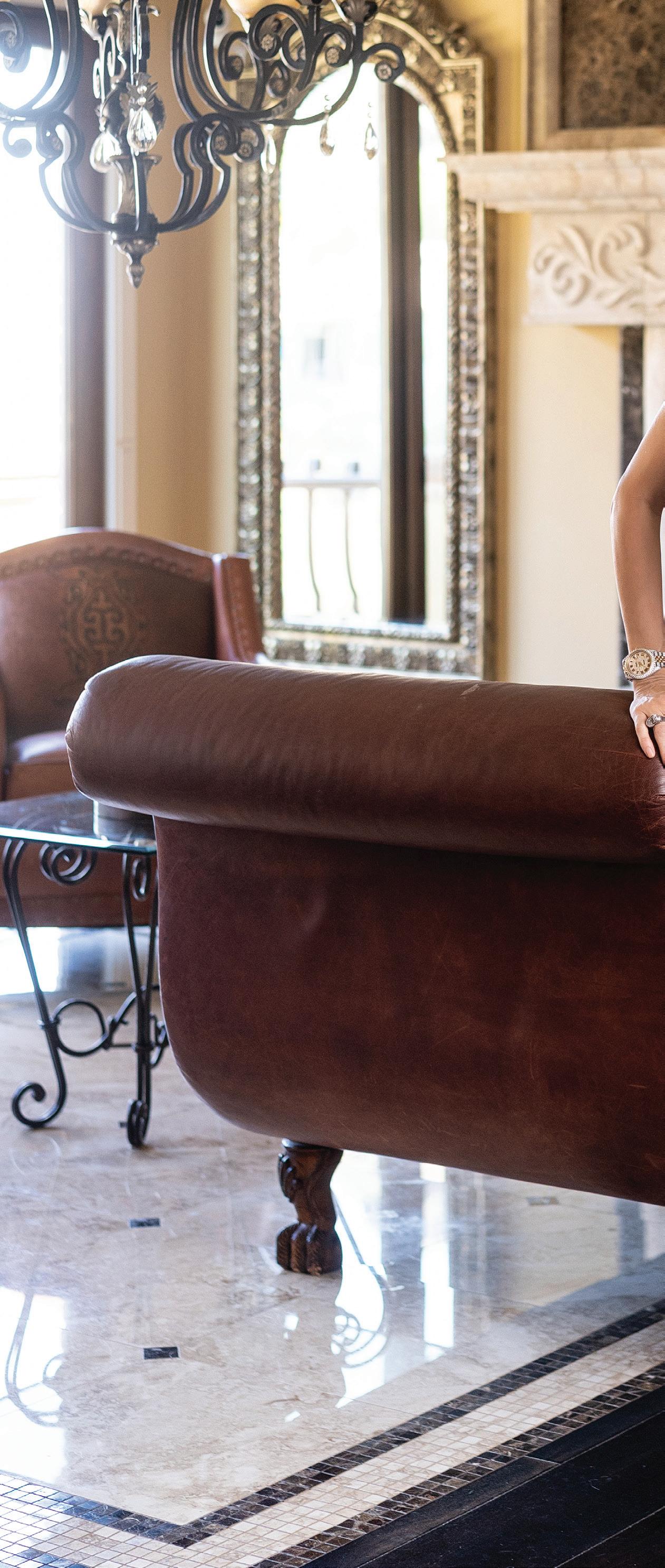
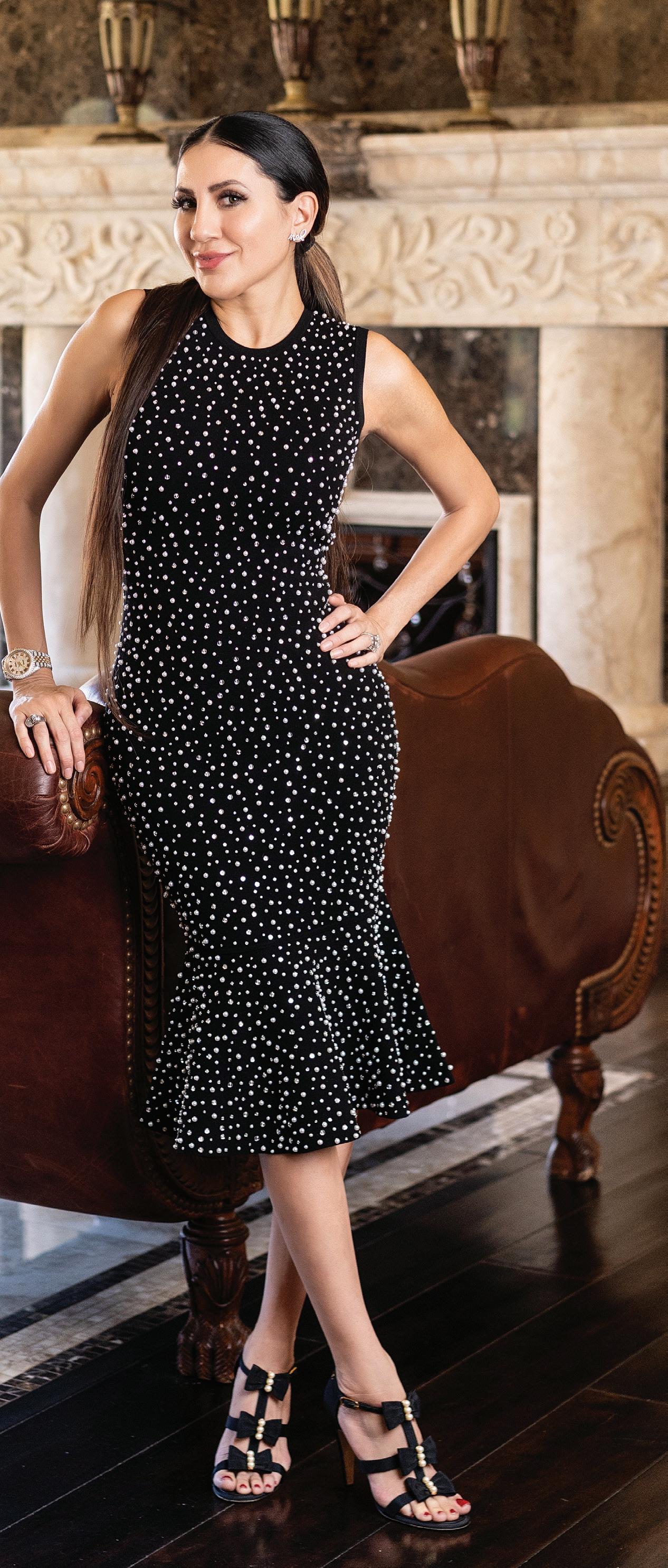
getting the Arizona Department of Health Services and the City of Mesa to approve the design. Then, she had to expand the store’s physical dimensions to accommodate additional aisles and shelves. Saloum admits she had no idea whether consumers would embrace the idea but, so far, the change has proved successful.
In addition to overseeing two dispensaries, a cultivation operation, and the medical-card platform, Saloum also owns several brands including Cigaweeds, which produces discreet pre-roll packs that mimic the look and feel of traditional cigarettes.
And, because clearly she didn’t have enough entrepreneurial activities to occupy her time, she also founded and operates Trap Culture, an Arizona events producer that since 2018 has blended cannabis and community at live musical performances, pool parties, and food festivals.
Despite a seemingly Midas touch in business, Saloum remains humble and devoted to her customers, staff, and community. She leads with her heart, drawing on personal experiences, a passion for patients, and a genuine drive to make a difference in the lives of those around her.
As a first-generation American, how does your background inform your business practices?
On my father’s side, my grandma had thirteen children and had to raise all of my uncles and my dad by herself. She still became a teacher and then eventually became the governor of the island my father is from: the Galapagos.
My grandma from my mom’s side is from Mexico. She had eight girls, and after her husband disappeared she did what she had to do to have her girls succeed. They struggled and they had bad days, but all of the girls, all of my uncles, everybody is healthy and happy today.
My mom is not someone to mess with. She is very much a mama bear. I’m very similar in that sense. And my dad taught me how to love and not be materialistic, because
those things don’t matter. He taught me that the real thing is people loving you, too. I think I got a little bit of everybody in that sense.
How do your relationships with family impact the way you operate your businesses?
Both of my brothers do different things for the businesses. One of them runs the orders in stores and has a pretty long list of other stuff that he does. He’s been with us since the [medical-card] clinics began. My other brother is more involved with the grow, running the day-to-day maintenance and keeping eyes on it, aside from myself and my husband who are everywhere we can be.
Sometimes we’ll get my son to help. He’s starting to work a little with us between his school, and it’s a beautiful thing to see.
So many members of my family can work with us, and I’m very grateful because it’s brought us all together.
You’ve been in the industry a long time, spanning both medical and recreational eras. How has the market evolved?
Cannabis is a bit more of an open topic now. You don’t have to stay quiet about it; you can have pride in what you do. When this industry began, we were still seen as drug dealers. So much time has passed that I feel people are way more open and understanding about the topic. [The plant is] becoming more accessible, and it’s more acceptable to talk about openly.
What’s your current take on the Arizona market?
The Arizona market is a funny thing. It’s had its peak, and I think right now it’s plateaued to what it’s supposed to be. But it’s ever-changing, so there are brands coming from other states to see what the consumer wants. Do you want Arizona brands or do you want something from another state, other brands that are popular?
What challenges have stayed consistent through the years?
The most difficult thing is that we still don’t have safe banking. I’m thankful for the small handful of banks that take our money, but we can’t get any loans and we’re not treated like a regular business by any means. It will be concerning if we can’t get safe banking soon. I don’t see how different cannabis companies are going to be able to expand, do greater things, and carry out more


research without any funding. I thought by 2025 we would be a little more ahead.
How is your supermarket-style, grab-and-go dispensary concept working out?
I’ve noticed people are often surprised and don’t believe they can just walk around and grab stuff. When we give them their shopping basket or they grab a cart, you can see their expression change to an “are you joking me?” look. The concept is something that’s never been seen here in Arizona, so it’s just fun seeing how happy people are.
I’ve also seen an increase in basket size, because people take their time and are able to see things without being rushed. The design has helped increase a little bit of revenue, so I can’t complain. It was a good risk, being the first to get this concept through the Arizona Department of Health. It’s been very exciting. I imagine other shops will mimic and follow the model, and I’m okay with that. Being successful brings competition—that’s natural.
Was there anything about the rollout that you wish you had done differently?
We worked with the space that the city of Mesa allowed us. As much square footage as we had, that’s what we worked with.
I would like more space to display more brands. We’ve maxed out on how many brands we can showcase, and I’m trying to figure out how to bring on more, because the more the merrier for me. I want to showcase every Arizona brand I can and put the focus on these local Arizona companies.
What’s your take on the role of consumer education?
I always say that if you can educate one person, they might just go and educate two more people and so forth. Our job is never done in that sense. [Cannabis is] still fairly new, even if it’s been around for over a decade now in the state. I love seeing people ask questions and then be like, “Oh, that makes sense. Now what about this?”
I recently met a lady at the market who didn’t even know we have medical or recreational cannabis here. That tells you a lot about how many people still are out there that we can teach. I think it’s everybody’s job. If you really care about the movement and want more people to understand what we do and why, it’s everybody’s job to help with that. There’s still a lot of things that we as an industry could teach the public to help us progress. Build understanding for
“I’VE FOUND THE MOST VALUE

people that don’t know anything about cannabis, how it’s used, and how it’s different from what they were taught. Let people ask questions and have the answers ready for them, because that’s the only way we are going to see people switch over to cannabis.
What’s your most effective marketing practice?
It’s a little bit of everything: having a good reputation, people having good experiences at your store, and so on. Referrals are the best marketing you can get, and they’re free. That’s the biggest thing. As long as people are happy, they’re the ones that are going to make your brand because they will post about it. They will bring people to your event.
I’ve found the most value in treating people right.
How do you create a working environment that keeps your employees happy?
We currently have about 165 employees, and I have people who are still with us from the clinic days. So some people were hired in 2011 or so and are still with us now in 2025.
I think what helps is that I don’t see myself as any different from any of them. One thing I always say is “if I can scrub a toilet, you can scrub a toilet.” I don’t see myself as above them and I try to understand them, especially because everyone is different. Every employee needs something different. Some of them need encouragement, some need structure.
I think what I do well is figuring out what each person needs and then figuring out how to be the best version of me for them.
How do you make sure the best version of you shows up for work each day?
It’s all day by day, and some are easier than others. I am a regular person, and there’s only so much I can do in a day. I’m trying to understand that more. I always make sure I give attention to everything. I may not always be able to give 100-percent attention, but if you need me, I will be there in a second.
I try my best to balance work and family, and it’s hard because work leaks into my home. My partner in crime is my husband and if I don’t see him all day, I’ll ask him how his day was. Yes, because he’s my husband, but also because I need to know what happened that day with the business. It’s a balance that is ever-changing.
What keeps you going when work gets tough?
Recently, I’ve been able to use my creativity and bring new products to the market. It’s exciting. Seeing Trap Culture be as accepted as it is, expanding Cigaweeds, all of that really excites me.
With the deli-style dispensary, I’m just a people person and I feed off people’s happiness. So when I see somebody like something, I want to do more of that. I think that’s what really keeps me going. Not everything works. That wouldn’t be normal; I understand that. But seeing people get happy with certain things, that’s the motivation that makes me want to keep trying and doing different things.
Ultimately, what drives you to make an impact?
Everything I do comes from seeing a need. There’s always a purpose for everything that we’ve created. Trap Culture was built out of the necessity of normalizing individuals who medicate but also want the joy of a good time outside of their home. It’s much needed in our community.
The Cigaweeds concept came from my husband, Arvin, who smoked cigarettes and wanted to get off them. We thought, with cigarettes, it’s the movement that people get used to. After you eat, you want to go have a cigarette. It’s something about that movement. So we made these joints to look like they’re actually cigarettes.
The clinics are where it all started for us. I love helping patients get off pills, and that’s why I started this all. I’ve seen the need in my own family, and there’s still much love in doing that for others.
Looking to the future, what do you want your legacy to be?
From budtenders to customers to other owners, when you hear that people like you, you know that they’re there because they want to be your friend. That matters more than anything to me.
When you die, people won’t think “oh, she had this, she owned that, she had this beautiful house or jewelry” or whatever, they’ll remember if you were a good person. That’s what I want at the end of the day. I want people to remember me like that—not for what I had, but that. That comes from how I was raised.

Thanks to exceptional planning and design, Puffin in New Brunswick, New Jersey, enchants with a controlled explosion of color and fun.

For a dispensary that sits near the smaller end of the size scale, Puffin packs an enormous visual punch. Outfitted in bright colors, light wood, and lots of glass and sporting an adorable stylized puffin logo, the 2,500-squarefoot shop near Rutgers University in New Brunswick, New Jersey, is the sort of place that beckons with a feel-good vibe.
“It’s a fun store,” said Georgia Peterman, business development representative for Display Dispensary, which designed the store’s floor plan and manufactured the fixtures. “You walk in and want to look around to discover all the cute things as you’re shopping.”
For Peterman and her colleague Jeff Sunga, outfitting smaller spaces poses unique challenges. Chief among them is a “need to cut the visual noise and make sure the design relates quickly and immediately while maintaining the elegance, elevation, and overall aesthetic of the brand,” Sunga said. Fortunately, Puffin’s owners “were decisive. They knew what they wanted and had a vision, so it was just a matter of translating that into the design.”
To balance the vivid color palette, the Display Dispensary team employed white display cases and storage cabinets. Both fade into the background, making the space seem larger and providing a neutral backdrop against which products pop. The cash stands and countertops were finished with raw-oak laminate for durability. All the fixtures were drawn from the Dispensary123 collection, then custom-fitted to ensure seamless integration.

To ensure customers weren’t overwhelmed by what might have been visual cacophony created by a surprisingly robust merchandise selection, Sunga and Peterman also used their backgrounds in fashion and retail design to create a merchandising plan for the store. The plan not only enhances the space’s “visual story” but also gives each square inch of visual space a dollar value.
“Some cases have risers inside,” Peterman said. As part of the firm’s consultation with clients, “we find out what kind of items they’re putting in cases and use our accessories to accentuate whatever they’re displaying.”
According to Sunga, “We always make sure items and brands are highlighted and it’s not just one big noisy mass of product. We like definitive lines and
a story within each brand or section. Otherwise, when you have so many SKUs, it all just becomes too much for the consumer to shop.”
For the future, Display Dispensary’s pre-engineered fixtures and custom touches provide Puffin with a versatile canvas staff can redecorate and repurpose to suit the market’s evolving needs.
“It’s kind of like your favorite pair of red shoes,” Peterman said. “You can dress them up or down for different vibes.”
Built out in thirty days, Puffin opened to an eager market of college students and soccer moms. Already, according to business-news platform ROI-NJ, the shop “has amassed a huge local following.”
Sunga attributed that to the store’s atmosphere. “It’s all about the sensation you get when you walk in,” he said.


BY ALLISON ZERVOPOULOS
Cultivation is evolving at a rapid pace, driven by the need for sustainability, efficiency, and profitability in an increasingly competitive market. As cultivators face mounting pressure to improve their bottom lines, innovation has become the key to thriving in a rapidly changing environment. Looking forward in 2025, several game-changing trends are set to take center stage, with potential to redefine the future of cannabis cultivation.
Here are just a few of the trends likely to dominate the conversation.
Precision agriculture is revolutionizing how we grow. Arising in the 1990s from traditional farming techniques, precision agriculture harnesses cutting-edge technology to collect and analyze data, offering cultivators the power not only to increase yields but also streamline operations and boost sustainability. While it’s still a relatively new concept in cannabis farming, the discipline’s rapid adoption makes clear that data-driven decisions are no longer optional for maximizing success. They’re essential.
Without data, growers are flying blind, uncertain whether their changes actually improve their processes.
Artificial intelligence (AI) also is growing in popularity. The technology allows cultivators to track every aspect of their grow’s environments—from plant health to environmental shifts, nutrient levels, and pest activity— with mind-blowing precision. AI-powered systems collect real-time data, identifying patterns and predicting potential problems before they occur. This gives cultivators a real advantage: the ability to intervene at the perfect moment to protect crops and optimize growing conditions, preventing costly mistakes and boosting yields.
Before AI, data collection was a time-consuming manual process prone to human error and inconsistency. But AI eliminates those challenges, giving cultivators the ability to fine-tune every detail of their operations with unwavering accuracy. From optimizing nutrient delivery to controlling light cycles and humidity, AI helps growers make smarter, faster decisions, leading to healthier plants, more consistent quality, and bigger harvests.
As the industry continues to mature, integration of precision agriculture and AI is set to define the future.
Growers who embrace these technologies are not just staying competitive; they’re paving the way for a new era in cultivation. With AI, every decision becomes an opportunity to grow smarter, yield higher, and create a more sustainable future.
Undercanopy lighting quickly is gaining recognition as a must-have tool for cultivators who want to maximize their yields and profits. The technique involves placing LED lights below or even within the plant canopy (a strategy known as inter-canopy lighting). By targeting the lower parts of the plant—often shaded and neglected— undercanopy lighting can prevent stunted growth and increase yields.
Cannabis plants naturally concentrate their energy and growth at the top, leaving the lower branches and bud sites to suffer from insufficient light. With undercanopy lighting, cultivators can shine light onto these shaded lower regions, maximizing photosynthesis and encouraging healthier, more robust growth. This targeted lighting technique helps develop fuller, more mature buds on the lower branches, leading to a more uniform and higher-quality harvest.
The impact on yields is impressive. Many cultivators report up to a 20-percent increase in overall production by incorporating undercanopy lighting. The significant boost in yield means growers can generate higher profits without needing more space or additional labor. By simply optimizing the existing grow environment, cultivators unlock more potential from the same square footage, making undercanopy lighting a cost-effective and efficient solution.
As the industry continues to become more competitive, maximizing every square foot of grow space is crucial. With undercanopy lighting, cultivators can achieve better, more consistent results with the same resources, improving both their bottom line and the quality of their product. In an industry driven by innovation, undercanopy lighting is a critical tool for those looking to stay ahead of the curve.
“Veg in place” is beginning to gain popularity among cannabis cultivators. The method involves establishing plants in their final growing location during the vegetative stage rather than transplanting them multiple times throughout their growth cycle. It’s a practice that’s not only efficient but also helps maximize space, reduce stress on plants, and improve overall plant health. As
more cultivators embrace the technique, its benefits are becoming increasingly clear.
Traditionally, cannabis growers started plants in smaller containers and transplanted them into larger pots as they grew. This process can be stressful for the plants, potentially slowing down their development or introducing transplant shock. With veg in place, plants remain in the same location from the start of the vegetative stage all the way through to the flowering phase. By skipping the transplanting process, plants experience less stress and can establish a stronger, healthier root system.
One of the biggest advantages of veg in place is the way the practice maximizes space efficiency. Rather than spending time moving plants around, growers can focus on optimizing the environment where the plants are. Since cannabis plants require specific environmental conditions to thrive, keeping them in one place allows cultivators to fine-tune factors like lighting, temperature, and humidity for optimal growth. This not only enhances the overall health of the plants but also can lead to more consistent yields and higher-quality buds.
Moreover, veg in place simplifies logistics in larger commercial grows. Transplanting multiple times can be labor-intensive and increase the opportunity to introduce human error. With veg in place, growers can streamline their workflow, reducing labor costs while improving consistency and predictability.
As cultivation becomes more refined and competitive, veg in place is emerging as an increasingly popular technique that combines efficiency, plant health, and resource management. By eliminating the stress of transplanting and optimizing space, cultivators set themselves up for healthier, more productive crops.
In today’s competitive cannabis industry, trends like AI, undercanopy lighting, and veg in place are essential tools for cultivators who aim to boost their profitability while minimizing environmental impact. The three innovations are not just about increasing yields but also enhancing sustainability by reducing energy consumption, labor costs, and waste.
As the industry faces increasing challenges, it’s crucial for cultivators to adapt, continuously improving operations to lower their carbon footprint, streamline processes, and deliver higher-quality products. By embracing these trends, companies position themselves to thrive in a rapidly evolving market, ensuring long-term success while contributing to a more sustainable future.
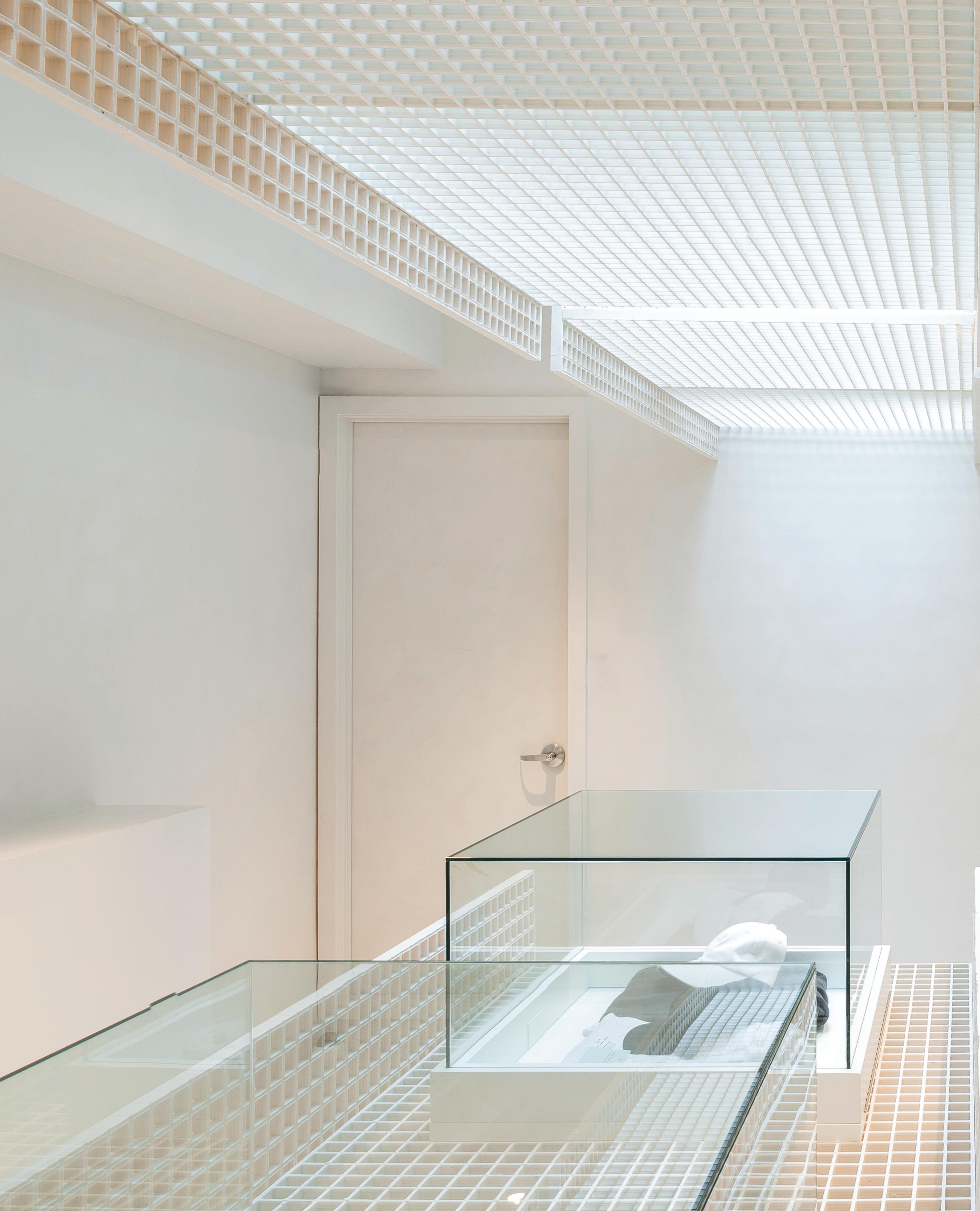
From high-end jewelry boutiques to big-box stores, dispensaries can borrow proven design strategies to boost sales and elevate the customer experience.
BY MICHELE MEYER

SO TAKE ADVANTAGE OF TACTICS TRADITIONAL RETAILERS HAVE USED SUCCESSFULLY.
Dispensary operators can expand their design horizons—and send sales soaring—by cribbing from the highest of high-end jewelry boutiques and the lowest of low-end supermarkets, not to mention beauty, big-box, and department stores. After all, many of those businesses seek the same goals and have weathered some of the same challenges experienced by cannabis retail.
We spoke with some of the best in the business, including designers who began their careers in traditional design before branching into cannabis. They shared the conceptual tools of their trade that could help dispensaries up their game in surprisingly affordable ways, from clever fixtures and varied lighting to color coding, bold signage, and arresting, adaptable displays.

To stay on brand, Toronto-based Visual Elements asks both traditional retail and dispensary clients to complete an extensive questionnaire. The answers provide the design team with brand familiarity, said Creative Director Desmond Chan.
“It makes the client think about what their brand stands for. ‘Everyone sells cannabis, but how can we differentiate?’” he said. “Our team learns the meaning behind the brand and its mission statement, and then we help set the client’s operation apart.”
Also consider creating a mood board, advised Wil Walker, president of New York’s Display Dispensary, a division of 100-yearold Econoco Corp. The companies cater to both conventional and cannabis retailers. Mood boards typically consist of inspiring images, text, and material samples that help designers, particularly in the fashion and homefurnishings industries, define and maintain the emotional tone and color palette for a project.
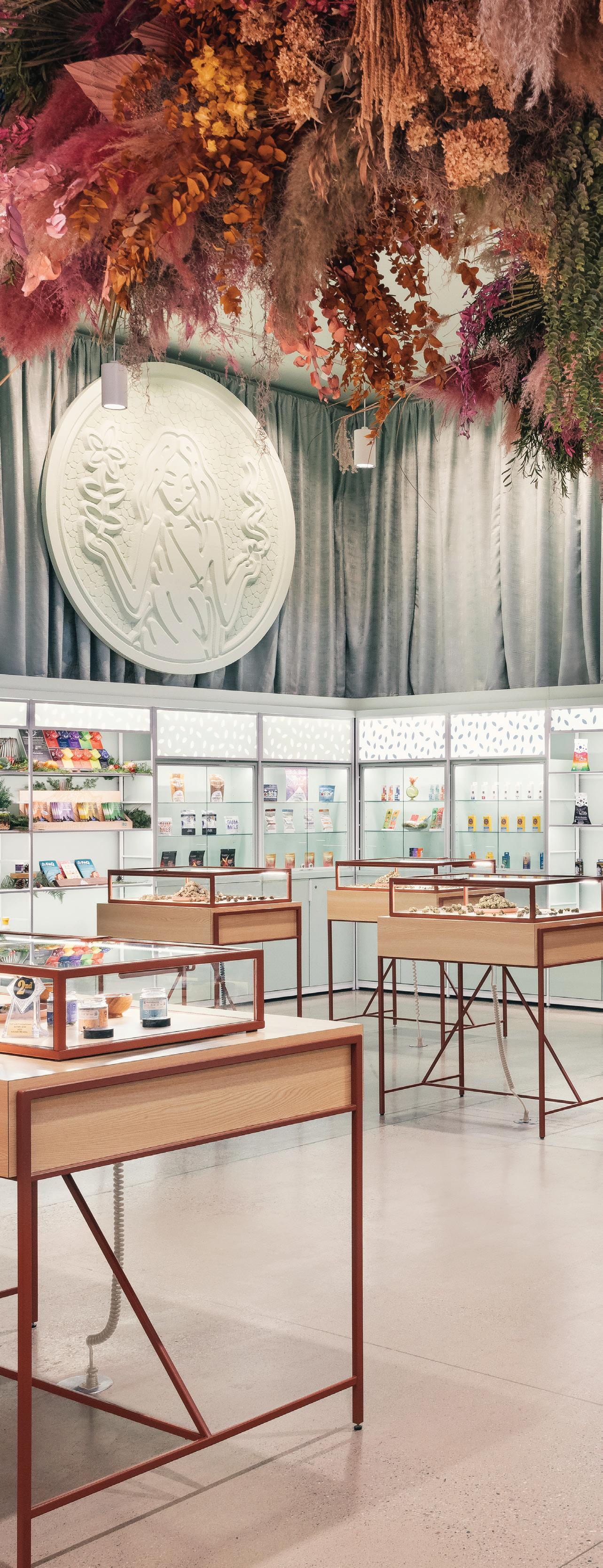
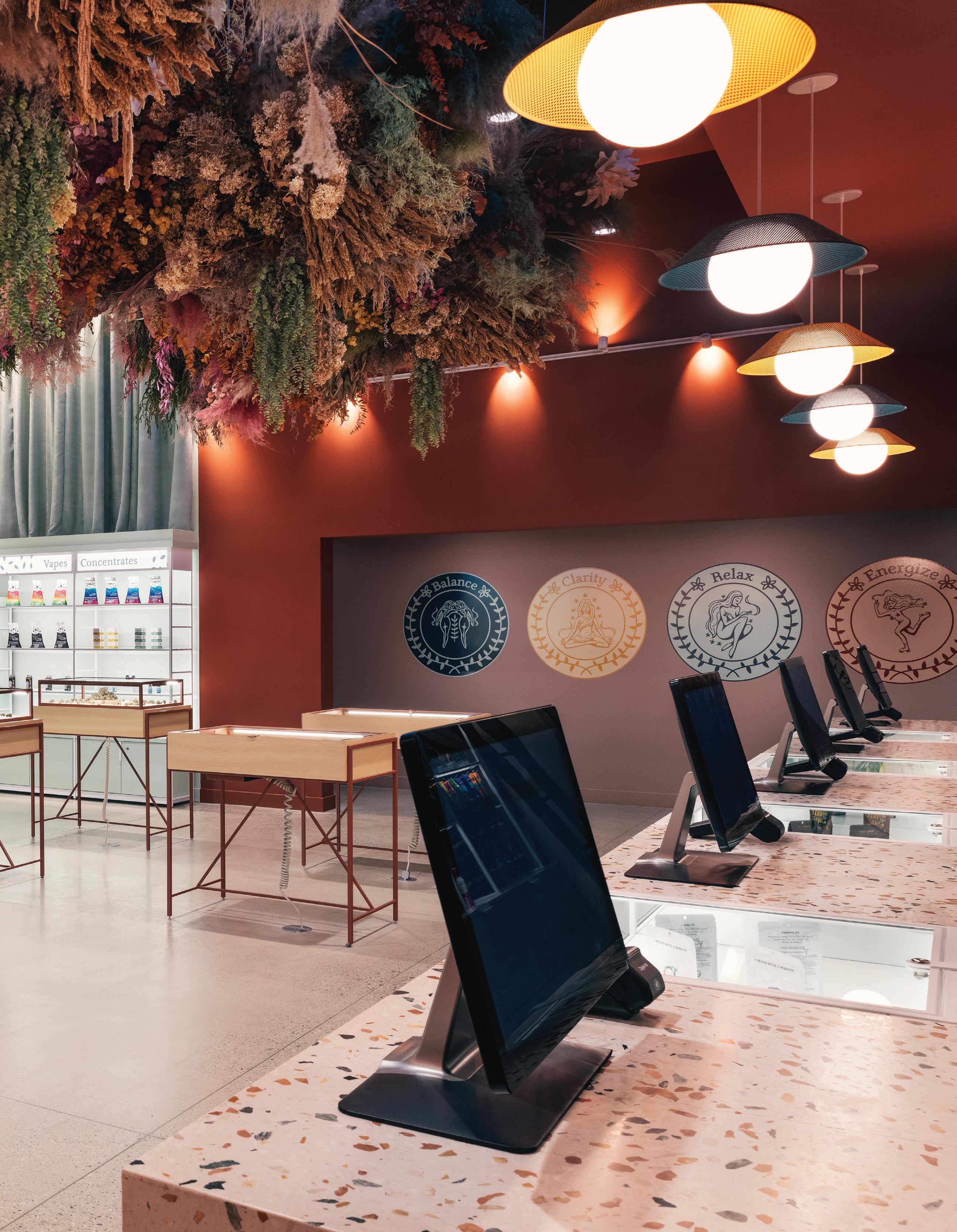
Spin a story.
Immerse customers in the brand’s story as soon as they enter the store, advised Danielle Marzarella, vice president of business development at Visual Elements. For instance, one Toronto-area dispensary has “a major retro 1970s vibe with a Volkswagen bus and TV screens playing shows from the era as soon as you enter,” she said. “So, you’re immersed in that environment immediately.”
Chan advised dispensary owners to “treat your store like a lifestyle destination and not a one-time transactional space. Dispensaries can do better at this.
“Your tale should start before you display a single item for sale,” he added, and the tale’s thread should run throughout the space, as threads do in the most evocative traditional retailers. “That’s how you transform shopping into an experience—and increase how long the customer stays.”
So, ask what lifestyle you’re trying to capture—and for whom. Then, spin a tale that will resonate with consumers who embrace that lifestyle or values system.

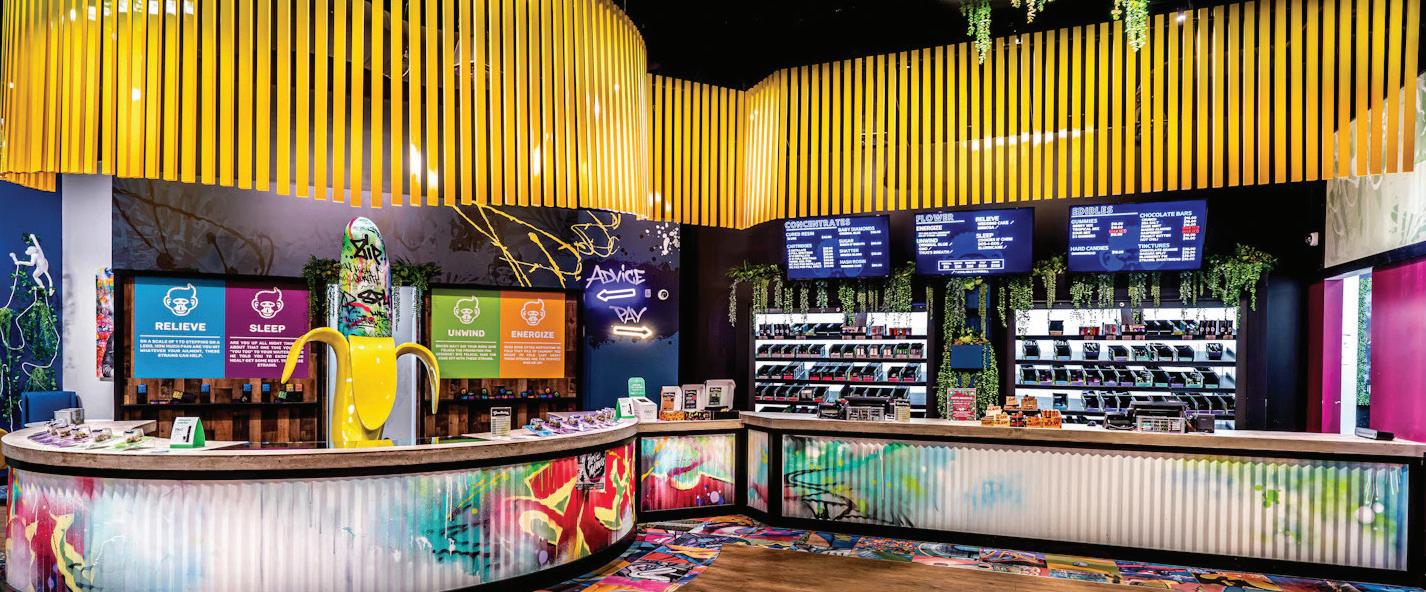
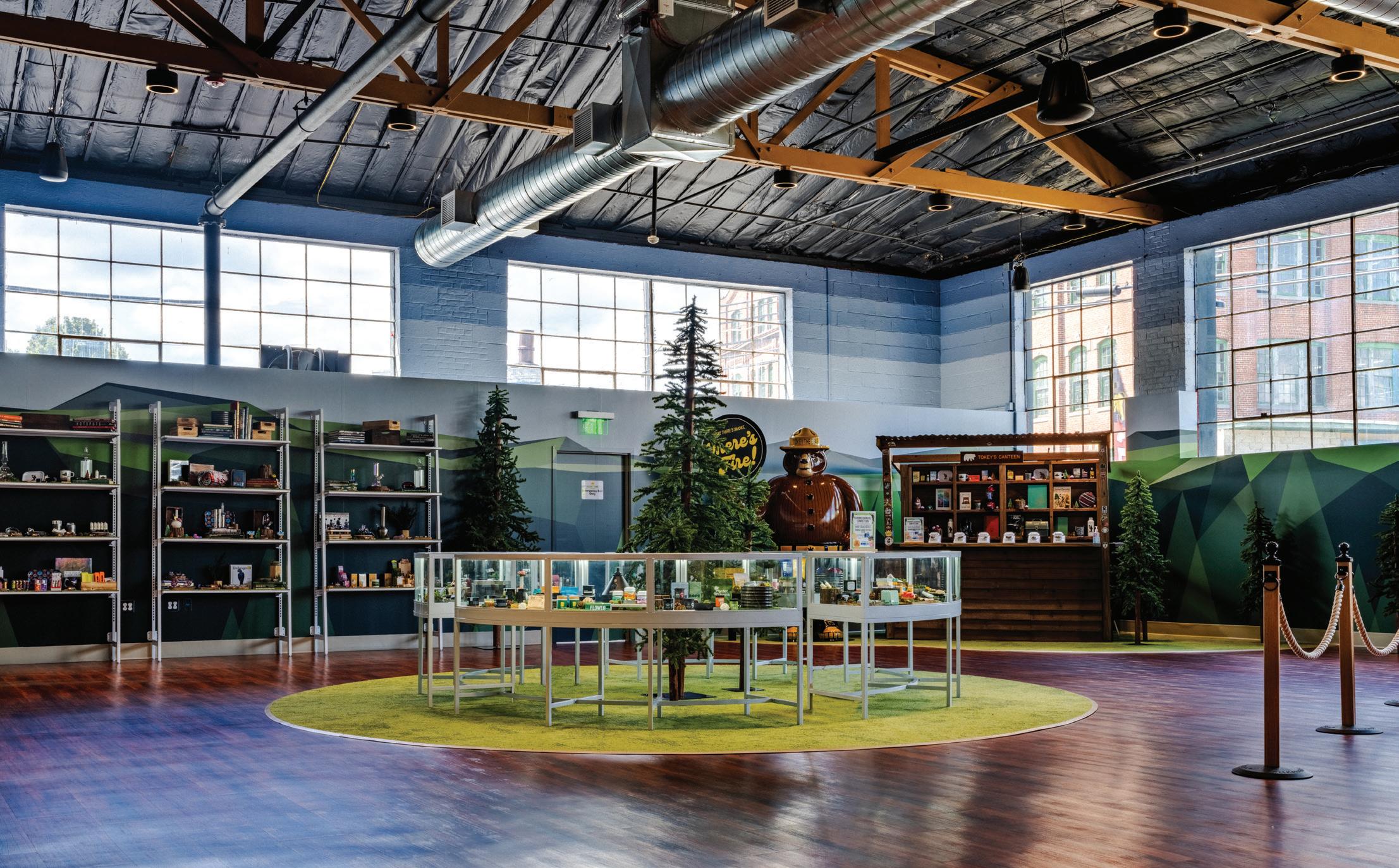
Boone Town Provisions in Boonton, New Jersey, riffs on a campsite theme—with a sense of humor. A bespoke ursine mannequin named Tokey the Bear catches customers’ eyes right away. Standing nine feet tall and holding a sign stating “Where there’s smoke, there’s fire,” Tokey lends a playful personality to the store. Wood and moss add amusement to display cases and lure shoppers to the merchandise.
“We pulled these ideas from traditional retail to encourage TikTok-ers,” said Walker, whose firm designed and manufactured both Tokey and the store’s fixtures.
Also encourage impulse sales with promotional items placed near the checkout stations. “These should go beyond branded T-shirts, ball caps, and hoodies,” Chan said. “Those are played out. Be creative. Determine what your shoppers want to buy.” Vinyl records? Non-infused food items? The possibilities are endless but will attract the most attention if they echo the store’s overriding theme.
“It boils down to a strong brand identity,” said Marzarella. “Once you know that, you can determine what outside-the-box merchandise you should offer. It must fit that singular vision.”
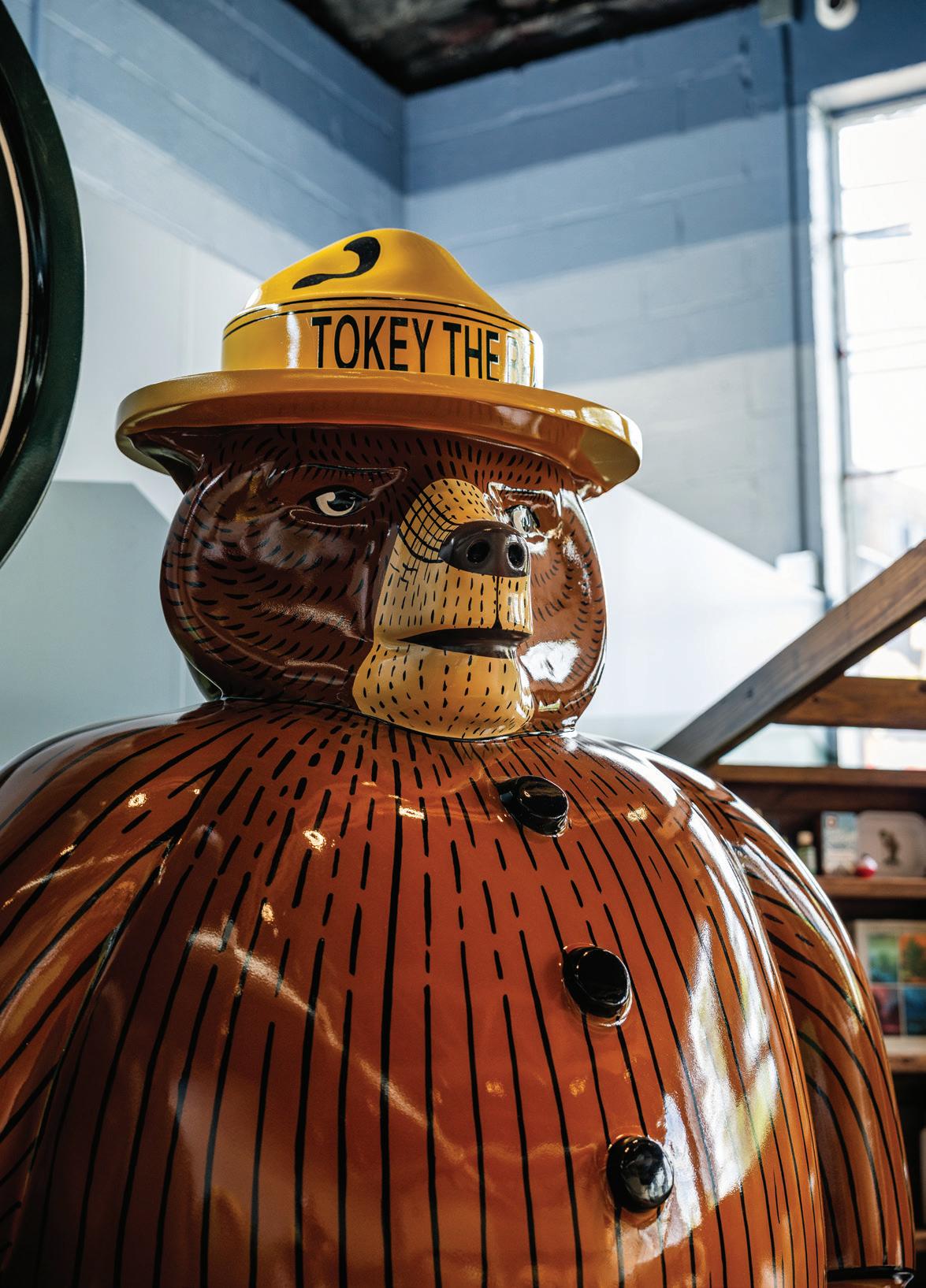

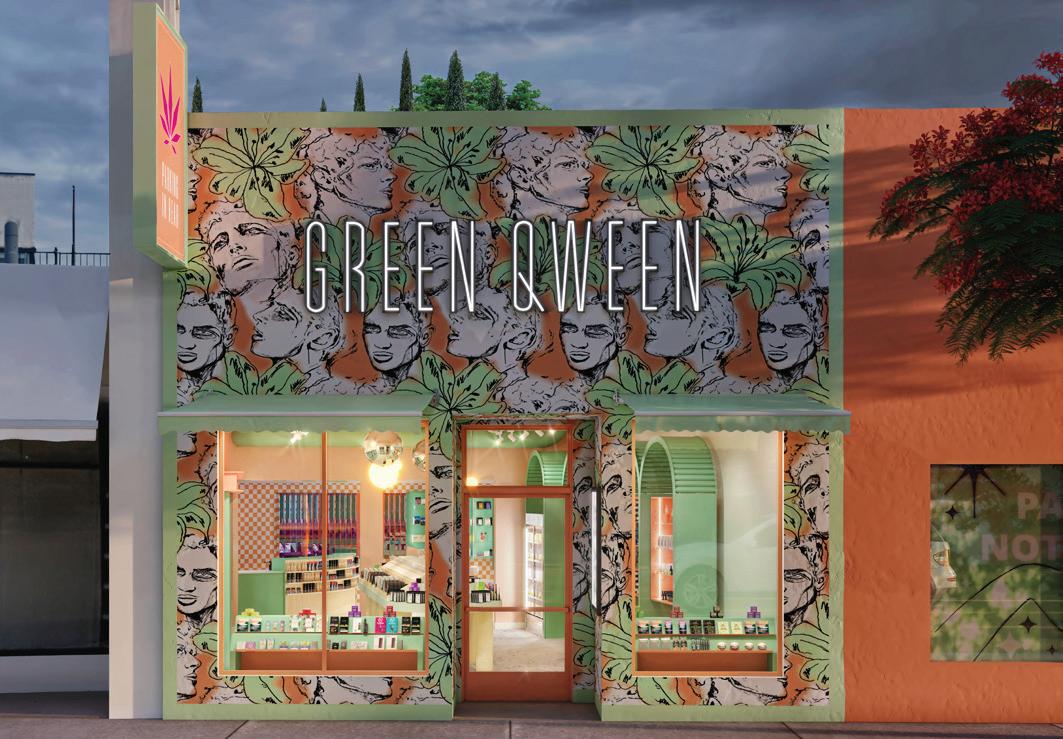


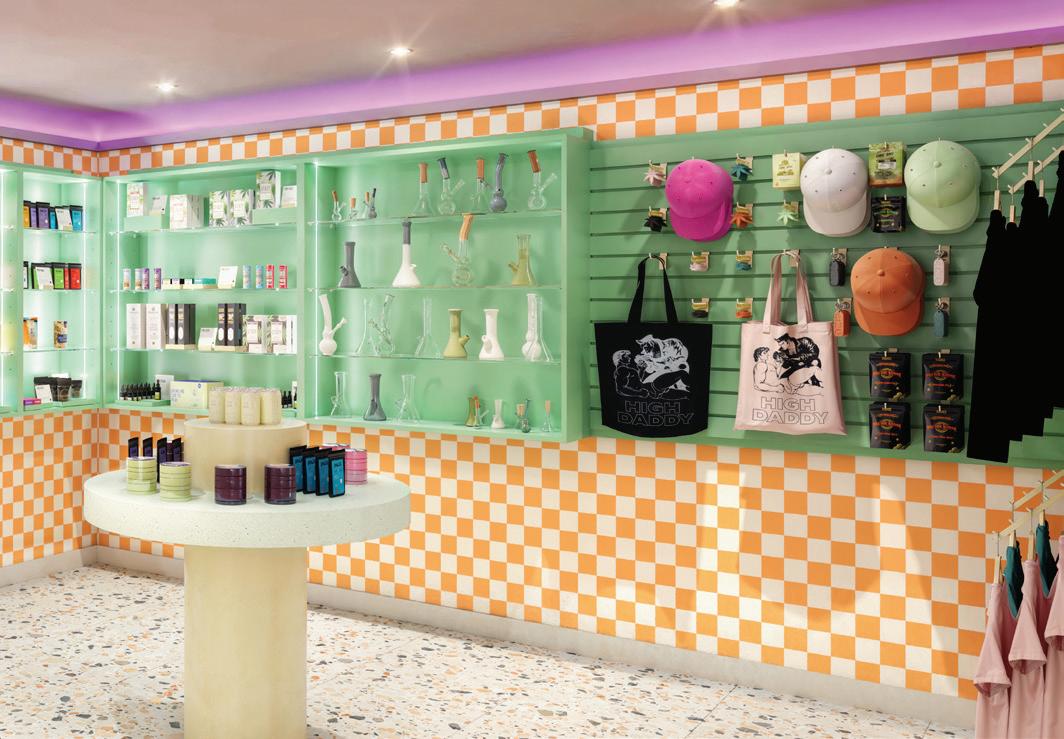
Pay attention to geodemographics.
Geodemographics is a fairly new field of study involving the way demographics, lifestyles, and behaviors interact to give neighborhoods and larger regions their own “local color.” Stores in gentrifying areas populated primarily by young, childless professionals should have a completely different atmosphere from those in areas where families and older consumers reside. The vibe in urban stores will appeal to a crowd that is wholly different from the crowd attracted to stores in rural areas. Chains and multistate operators must be particularly attuned to the differences between markets.
“Each store should be uniquely different, based on the location it’s in,” Marzarella said, adding that doesn’t mean designers should throw branding out the window. Stores can be tailored to the neighborhood clientele yet retain branding elements that identify them as part of a larger family.
In the cannabis industry, Green Qween’s dispensaries do an excellent job of both cleaving to the family’s genetics and fitting in with diverse communities. Marzarella called the chain “a beautiful story.”
“Each location reflects the community,” she said. “One has a bodega-type style as a nod to the bodegas in Sherman Oaks, mimicking ’60s and ’70s grocery displays. You can have fun being creative with your displays and inventory based on the location.”
Hugh Boyd, principal at Hugh A. Boyd Architects, advises dispensaries to “design for your marketplace, as we do elsewhere in retail. We might use warm woods and flat white cases in areas such as a small Midwest town, but in hip urban areas you can go much more upscale with materials.”
Just as traditional retailers place impulse buys near cash registers, dispensaries should place tasty treats along the path to popular purchases. Depending on the customer base, these might include lovely lighter and ashtray sets, beautifully packaged papers, eye-catching rolling trays, or other accessories Chan said.
“Many chain stores and fashion boutiques place clearance wares at the back of the store,” he said. “Dispensaries can do this, too, and have customers pass grinders and rolling papers along the way.”
Stock seasonal items and limited editions at the front of the store, so customers feel there’s something fresh and unexpected to be found, enticing them to venture inside. And make sure customers easily can spot displays tempting to TikTokers and other social-media mavens. Even casual influencers may turn out to be your best promoters, Walker suggested.
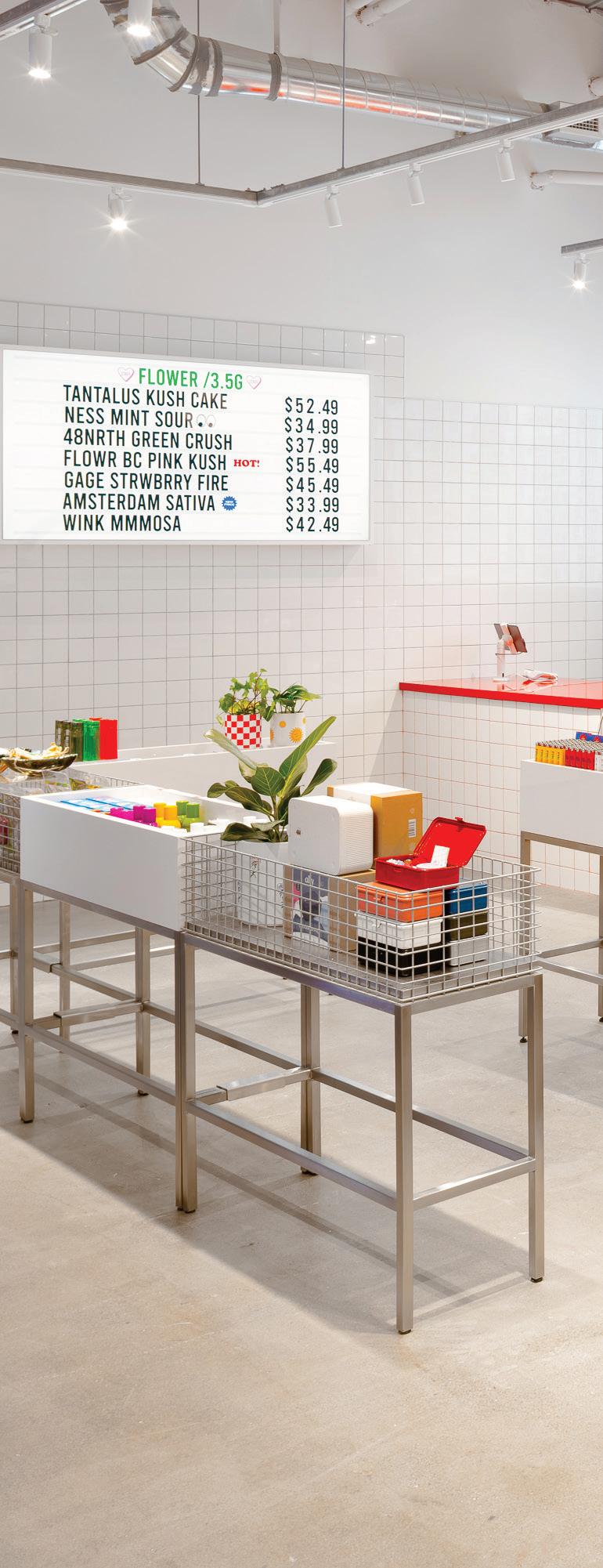
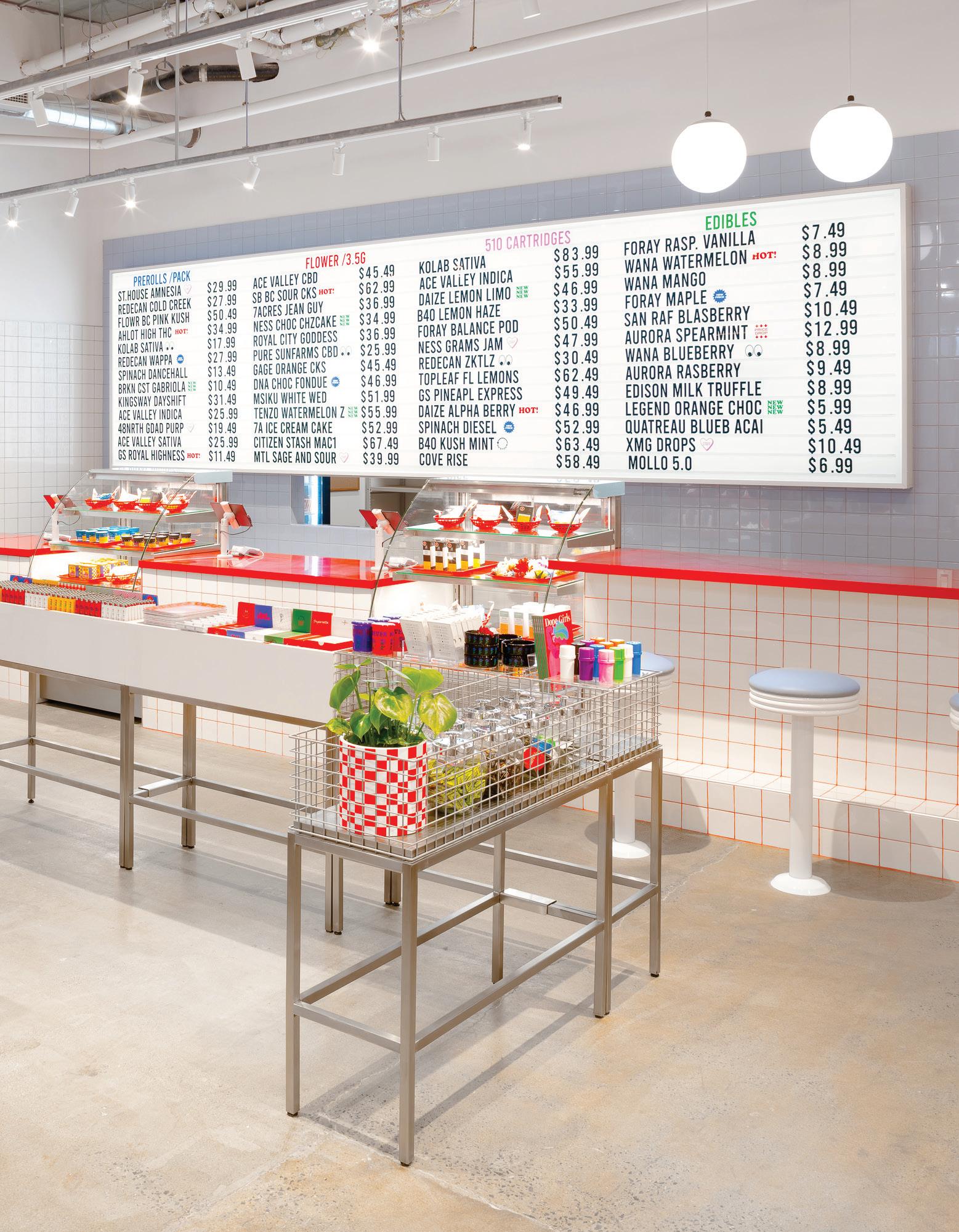

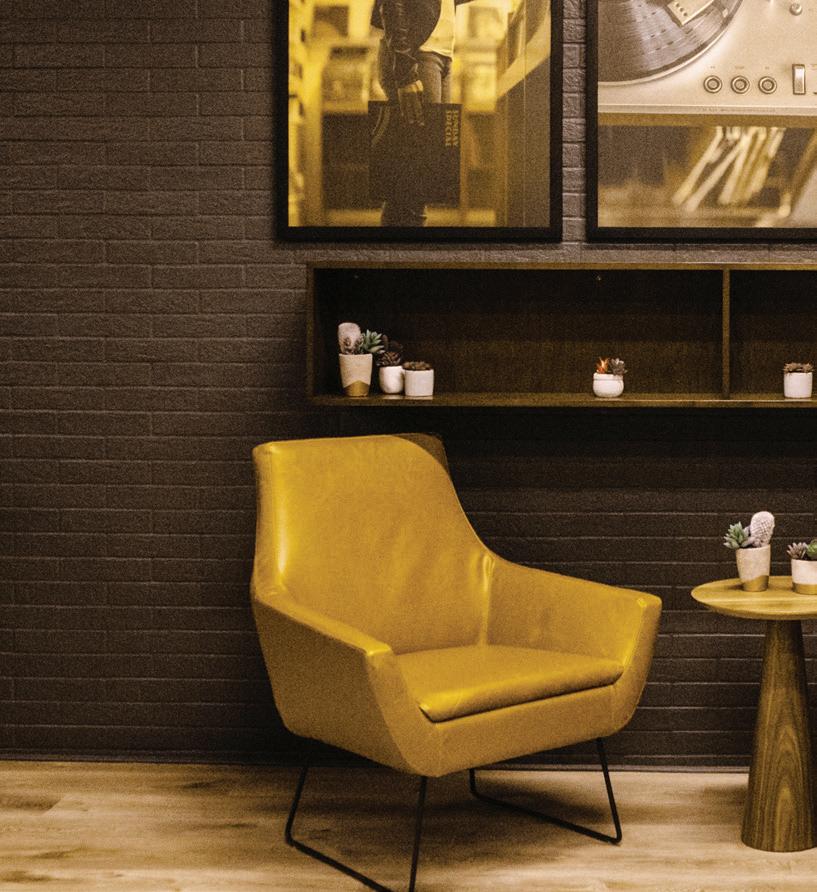
Meticulously organize the back of the house.
Ensure whatever backroom real estate you have remains highly organized, just as shoe stores do. They group products by category, brand, color, and size; dispensaries can employ the same process. Meticulous backroom organization will speed customer throughput and perhaps reduce the space needed for stock, Marzarella said.
“If you don’t have spare space, use backof-the-house shelving,” she suggested. “Also, categorize products by expiration dates. A good designer can find ways to deliver the space for that.”
Of course, a successful front of the house will be as well-thought-out and organized as the storeroom.
“The point is efficiency and flow in your layouts,” Chan said. “It’s about how a product goes from delivery at the back door to out the front door after the sale.”
Just as grocery stores offer express checkout lanes, dispensaries can allocate one or two points of sale for quick checkout or for online purchase pickups. “Some people are there just to pick up and get out quickly,” Chan said.
In addition, just as grocers place impulse items such as bubble gum and magazines at the point of sale to encourage impulse buys, dispensaries can take advantage of shoppers’ wait time. Position papers, edibles, and matches on the path to the cash stands, or splash them on LED screens containing menus and marketing material.
Even impulse purchases may require education, Chan said, offering another touchpoint for consumer interaction and upselling. “As at other stores, you need knowledgeable staff to educate customers about products and their benefits,” he said.
Digital signage reminding shoppers about sales also can be beneficial at the point of sale, Walker said.


Most shoppers appreciate a chance to orient themselves within their surroundings before getting down to business. “Breathing space” at the front of the store allows them to unwind from the hassles of daily life and refocus— hopefully on their purchase plans.
High-end retail stores often greet customers with a feature wall, perhaps with a mannequin or a display that’s intriguing and on-brand while keying into the shop’s concept, Marzarella said. Even chain department stores refrain from assaulting shoppers with merchandise right away, Walker pointed out. Target, for example, leaves about fifty feet between the entrance and the first product.
“That’s because people need time to adjust to the space,” he said. “If you hit them right away with products, it will throw them off. They need a cooling-off period—time and space to escape what was on their mind walking from the car to the store. Then they can get into the headspace of ‘I’m here to buy something.’”
Point the way to popular categories, sales, checkout counters, or other essential points of interest with easily read signs visible from across the store and from any angle, Chan recommended. “Clear signage like you see in grocery stores lets customers who are in a hurry reduce the time and friction spent in the shopping experience.”
Also provide well-marked areas for pick-up or to-go items and for those wanting in-and-out (quick) service.
“Dispensaries also have potential for menu boards with great graphics like you see in a pastry or coffee shop,” Boyd said. Digital signage is easy to change to meet evolving needs, he added. They also allow retailers to provide real-time pricing and promotions.
Bombarding customers with a menu containing every item in stock is a recipe for decision paralysis. Instead of finding just what they seek, customers may become so overwhelmed by choices that they end up purchasing nothing at all.
“You don’t want to overwhelm your customer, nor do you want a cluttered, cheap look,” said Cindy Lam, principal designer at Remedy Design Group in Los Angeles.
“McDonald’s and In-N-Out don’t oversaturate their menus. They know what their customer craves, and that’s what they offer. If a dish’s sales are weak, they remove it.”
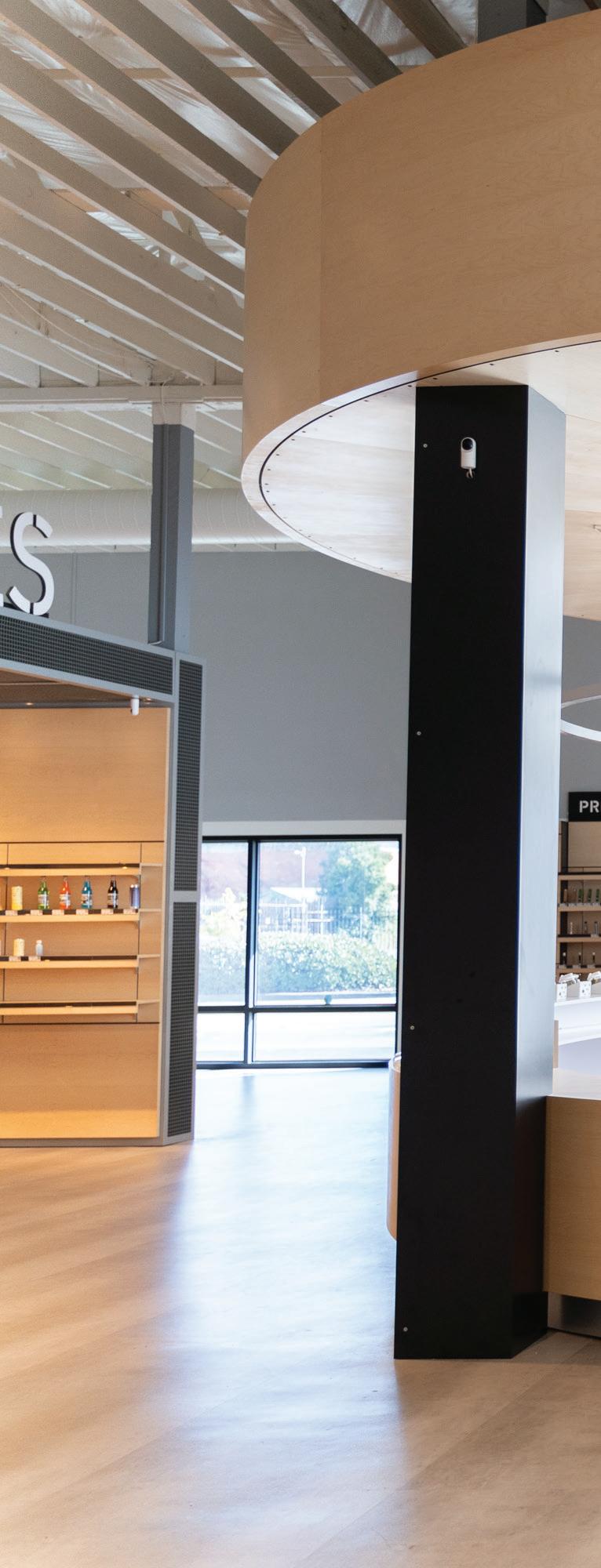
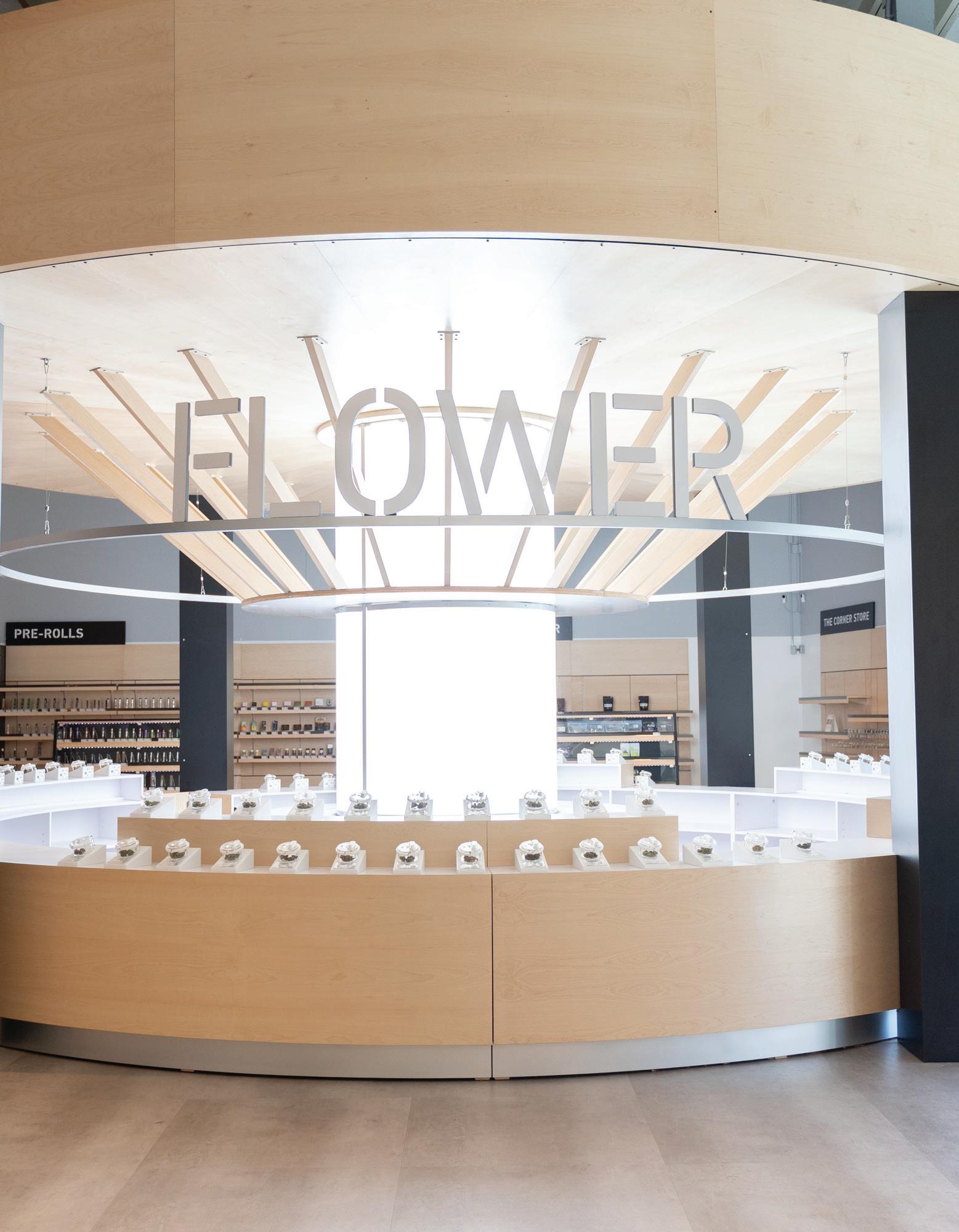
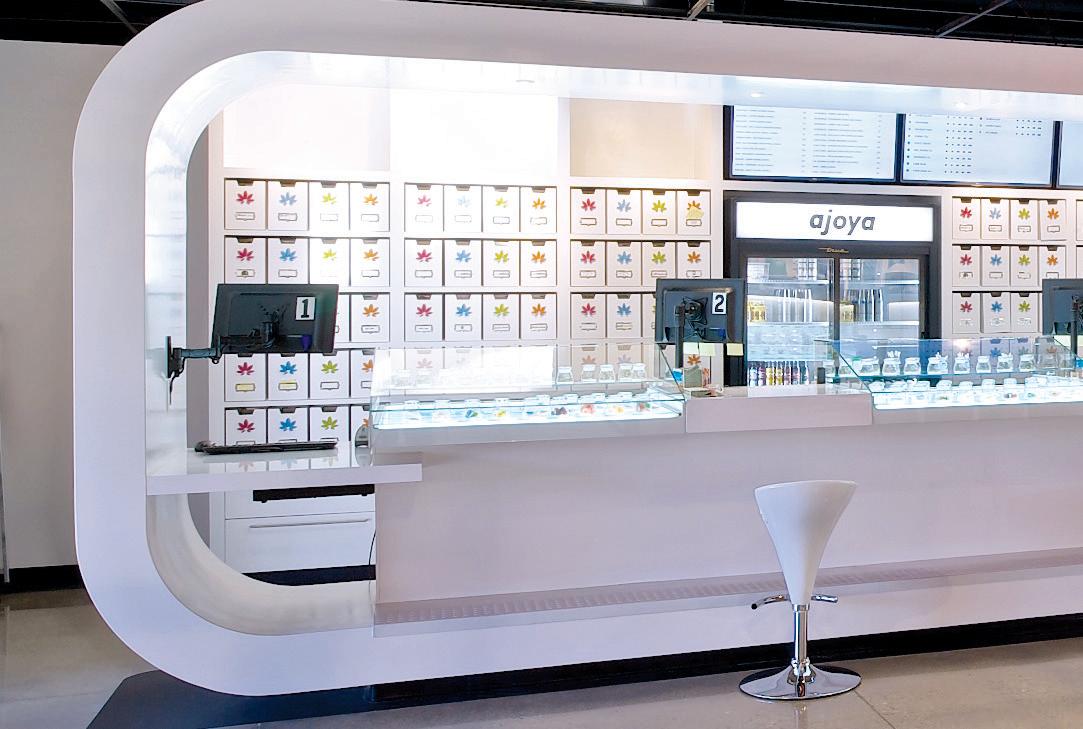
for fish, meat, and produce so each looks fresh and seduces the shopper.
As for dispensaries, proper lighting helps customers see flower color and texture. “Really great lighting would have a great impact on sales by making the product look very desirable,” Boyd said.
“The best light I’ve seen in a dispensary is direct lighting with tiny spotlights—almost the smaller the better—to highlight leaf texture,” said Boyd. “The right lighting for specific products is critical. Lighting can enhance or take away from the product experience.”
When Boyd designs grocery markets and food halls, he chooses different shades of light
In addition to color, lighting’s intensity and temperature (warm or cool) affect customers’ perception of the products on display. “Leaf texture and color are so subtle, so you don’t want to overlight or use general lighting that’s too bright,” Boyd said. “Instead, use a focal light, because the customer’s eyes go to the brightest object in the space.”
He considers cannabis “unique retail. I compare it to a really upscale wine store, where ultraviolet light against the bottles makes it almost like a museum store,” he said.
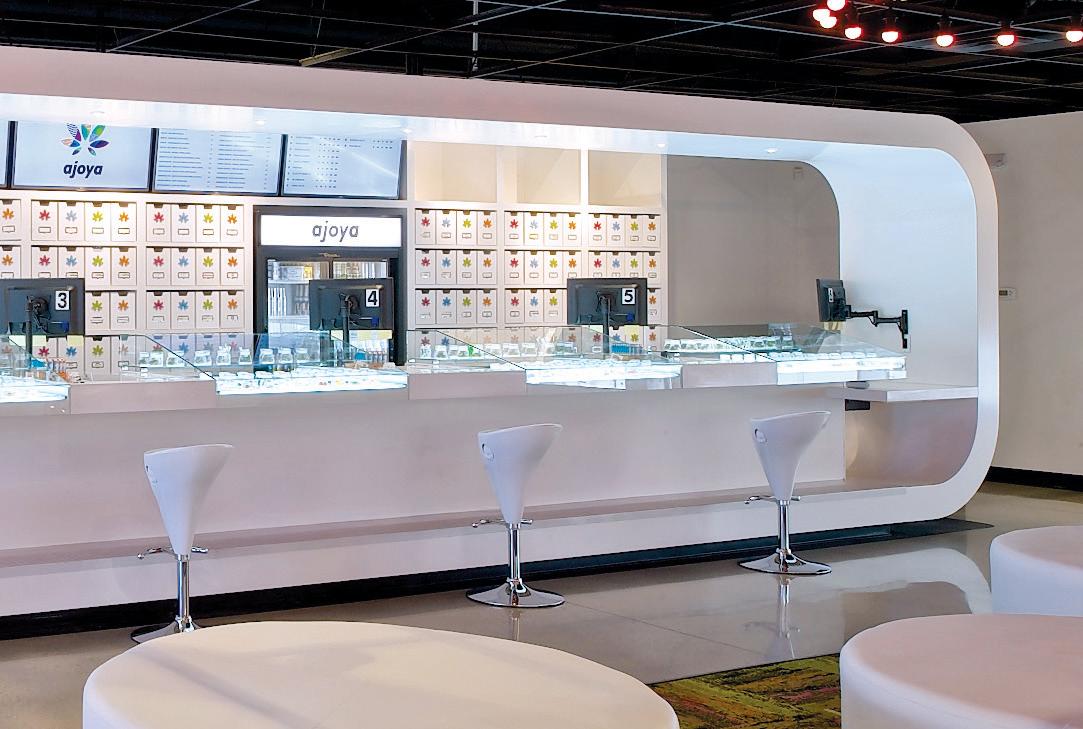
“Dispensaries are retail spaces, but they should have almost a hospitality feel. Besides strong focal lighting on each product, elsewhere you want fun and decorative lighting to give the space energy. You may want lighting like you’d experience in a bar or a coffee shop.”
Within cases, borrow from museums and jewelry and pastry stores, Boyd advised. “Often jewelers use spotlights on tiny poles that they scatter in glass cases,” he said.
Ultimately, lighting’s goal is to goose sales through subtle cues. “Cannabis often isn’t something you need,” Boyd said. “It’s something you want.” As it does in fine jewelry stores, the right lighting can turn up the want factor.
Also as in jewelry boutiques, lighting must be tailored to match the expense of the items on display. Lighting inside cases displaying craft-
grown, small-batch flower should be higher end than the lights used to illuminate a rack of mylar bags.
“Lighting is a storytelling tool and helps set the mood,” Chan said. “It’s one of the most important elements—pivotal to telling your story throughout.” Soft, focused lighting even can elevate the perceived value of products, he added.
The one type of lighting best not used is the harsh, fluorescent lighting typically used in pharmacies, according to Chan. “Warm and soften your overall lighting to be inviting, and use focus lights to highlight luxury products and promotions,” he advised.

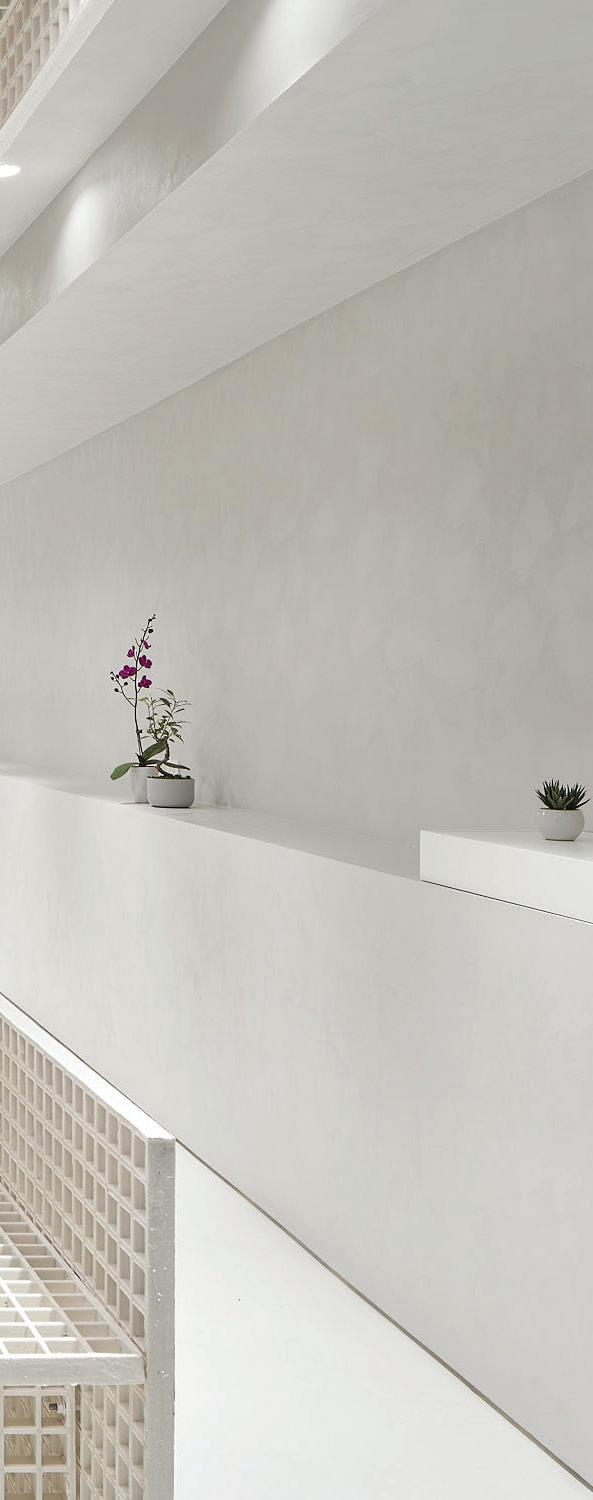
Set a mood.
Sophisticated museum stores and boutique jewelers are masters of psychological marketing. They realize subtle sensory triggers can set a mood that nudges shoppers into a ready-to-buy frame of mind.
Dispensaries can set a mood from the get-go with lighting, music, and even barelythere fragrance. Just be careful environmental scents don’t compete with the aroma of the products, Boyd advised. Like fine tea leaves, each cannabis flower emits a unique medley of aromas.
In addition, “any music should reinforce brand identity and contribute to the store’s energy,” Chan warned.
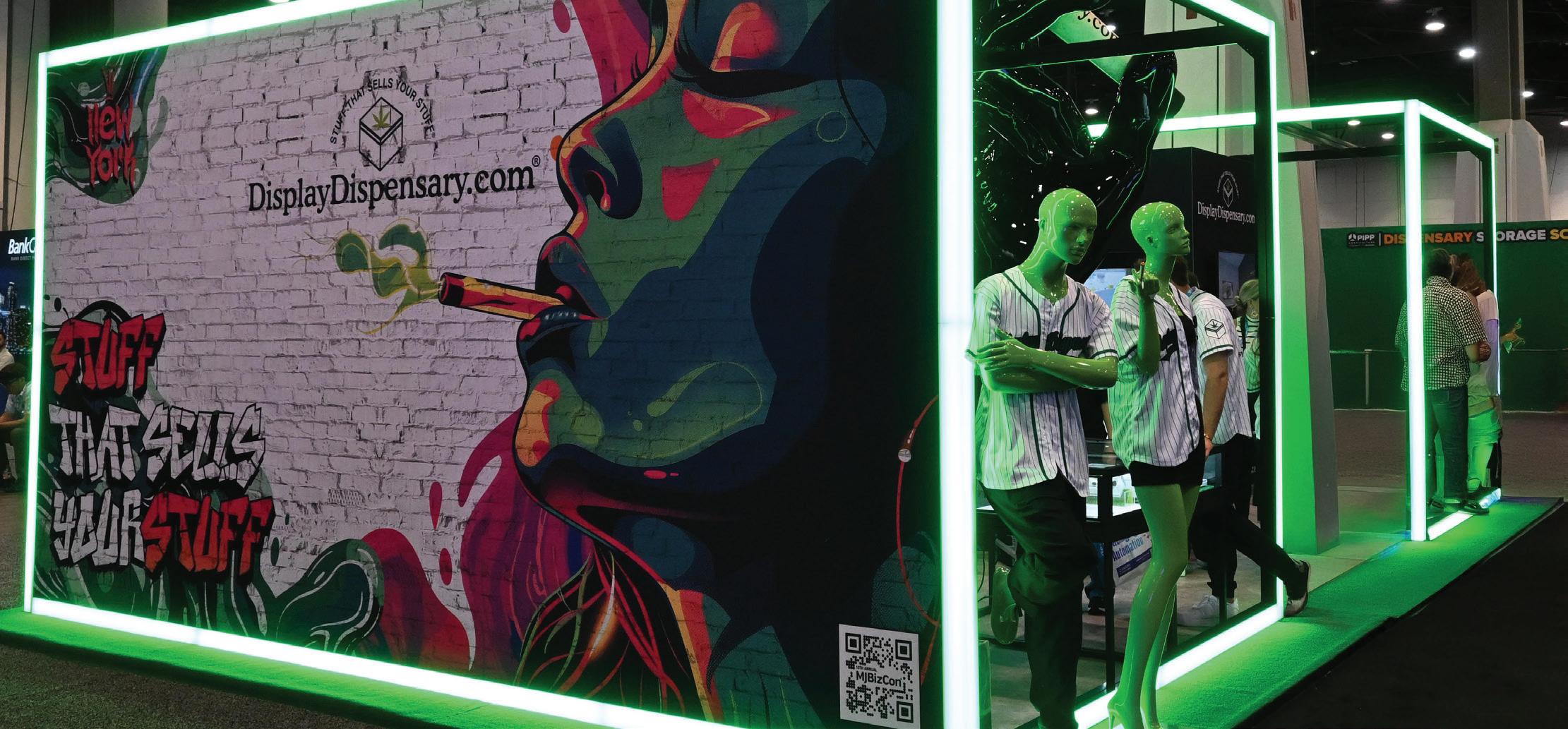
Mannequins displaying products can surprise and delight customers, turning an ordinary shopping trip into a visual adventure. A hand holding a flower in a display case makes an unexpected statement, for example. “A mannequin can seem to be rolling or smoking a joint,” Walker suggested. “It’s such an underused technique. So are carts or trolleys displaying the hot product of the month.”
Walker also has used faux lemons to jazz up displays of the strain Lemon Haze. “Add texture and color to elevate the display,” he said. “It’s about thinking outside the box.”
Also consider bringing in a tree, plant, or moss wall to warm up the space, he suggested. “Instead of avoiding nature, own it; run with it. It’s beautiful when done well. But it cannot be fake.”
According to Lam, “Retail is theater. Use props to engage, drive traffic, and entertain.”
Combining premium brands with similar customer bases creates synergy and buzz—and can lend additional cachet to the best-selling products from both. Collaborations are a timehonored tradition among product brands, but dispensaries haven’t leaned into the trend … yet. They should, Lam said.
Collaborations between dispensaries and product brands are custom-made for generating social-media buzz, she said. In the store, place items toward the front where shoppers can’t avoid them. Even if the merchandise is merely repackaged versions of your traditional bestsellers, they’ll feel new again to consumers.
Retail partnerships like those between uberhip global eyewear chain Gentle Monster and the gaming world’s Tekken8, and Pat McGrath Labs’ bestsellers reproduced in limited-edition Candy Crush Saga-inspired striped cases proved magical for the partners.
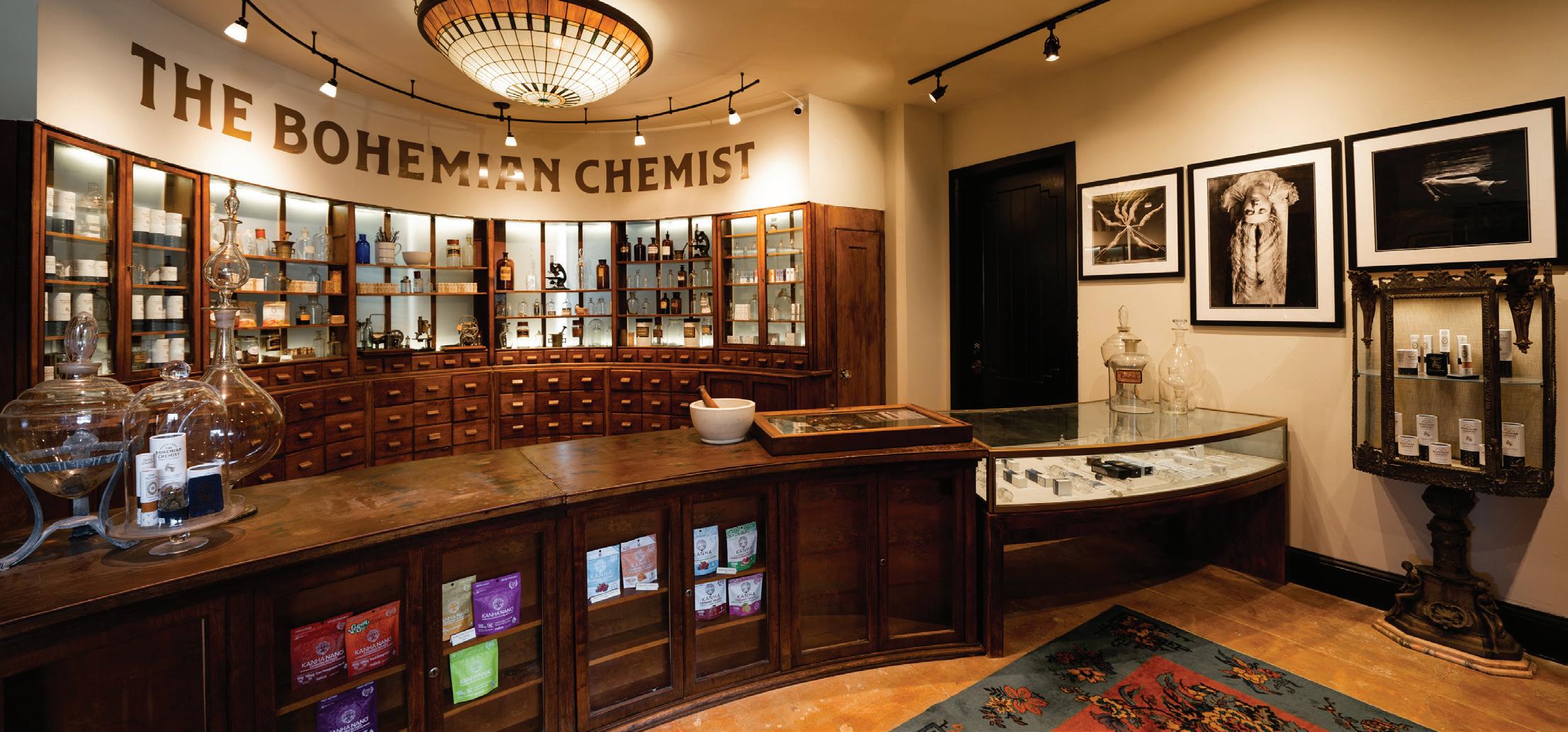
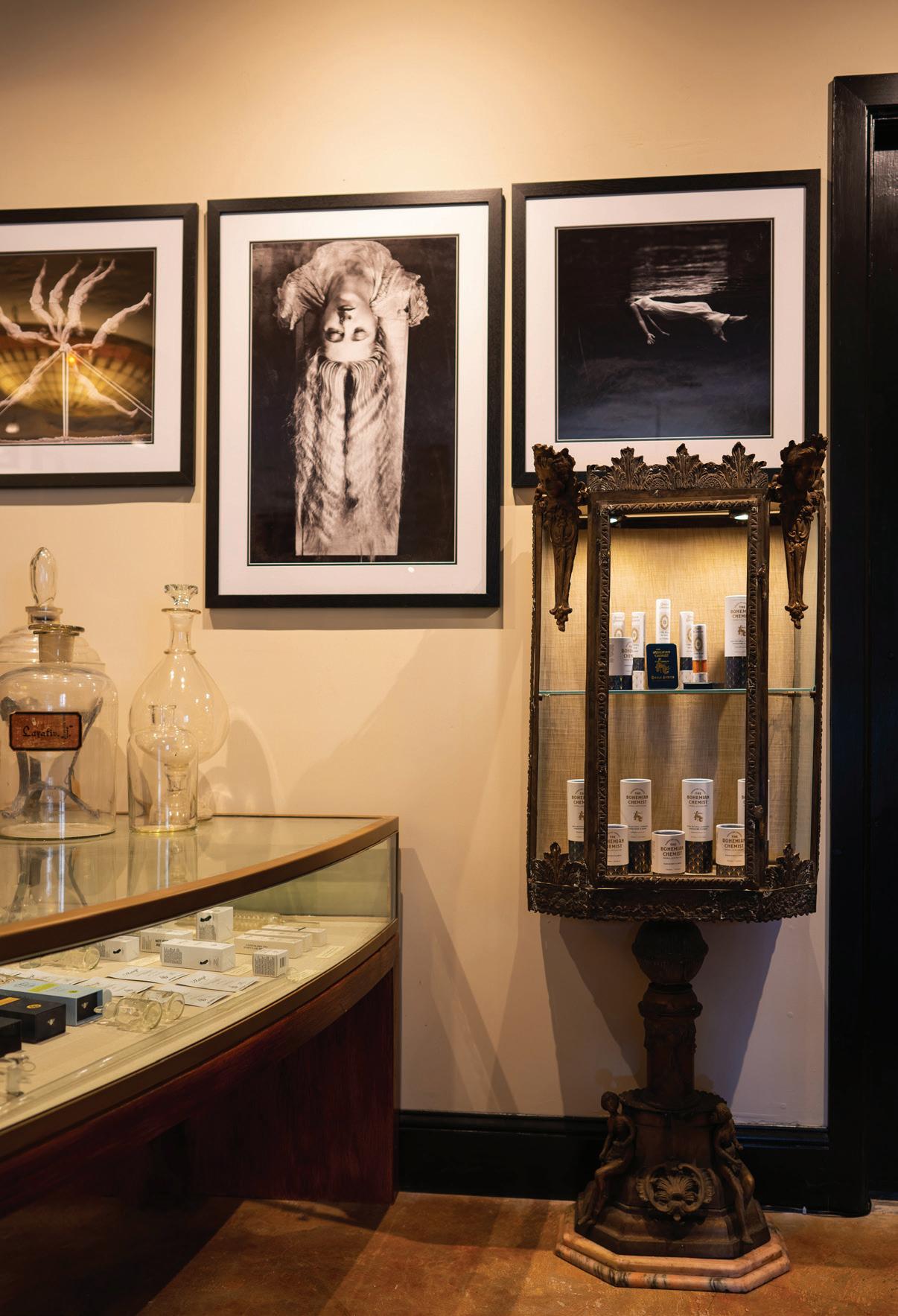
Establish “stores within a store.”
Partner with accessories or lifestyle labels to offer select wares, ideally as exclusives.
Dispensaries can flaunt merchandise by placing it at the end of aisles, with color-coded fixtures and signs for each brand. The same fixtures can make the scene a store within the store. “One wall bay can be dedicated to Brand A and another with a different color theme to Brand B,” suggested Lam, whose mainstream cred includes in-house design stints at Starbucks and Cole Haan.
Appealing oversized graphics and images can become inexpensive ways to alert customers where they can find their favorite products. Area rugs also can announce a section worth checking out, she said. “Too often dispensaries design horizontally but forget they can go vertically too,” she said. “So when [your competitors] go low, you go high.”
Even stores with a less technologically inclined clientele can make use of devices like iPads and ordering kiosks—as attentionattracting novelties, if nothing else. Place iPads where both customers and budtenders can reach them easily. The point is to deliver personalized information to salesclerks and allow shoppers with an independent streak to learn about and purchase products on their own terms.
Obviously, dispensaries want to generate long-term customer loyalty and not just onetime transactions. Digital devices assist with that goal by capturing customer profiles and purchase histories, Chan said. Not only do shoppers feel heard when future interactions display a knowledge of past favorites, but the dispensary also can respond faster and better at each visit.
“Maybe they’ve forgotten what they ordered [previously],” he said. “Imagine if the vendor can pull up their records and see what they liked or disliked in the past. That builds loyalty and education. These are key lessons from traditional retail categories.”
Artificially intelligent systems are particularly adept at keeping the score, said Walker, who frequents Sephora “because they have very knowledgeable people, a wide variety of products, and use AI to know everything I use for my sensitive skin.”
Consumers seek products for recreation, pain, anxiety, sleep, and a host of other conditions. All that information can be tracked in an AI-assisted system to help predict future behavior based on past interactions. Walker recommends using AI to suggest products that may address customers’ needs better or new releases they may enjoy trying.
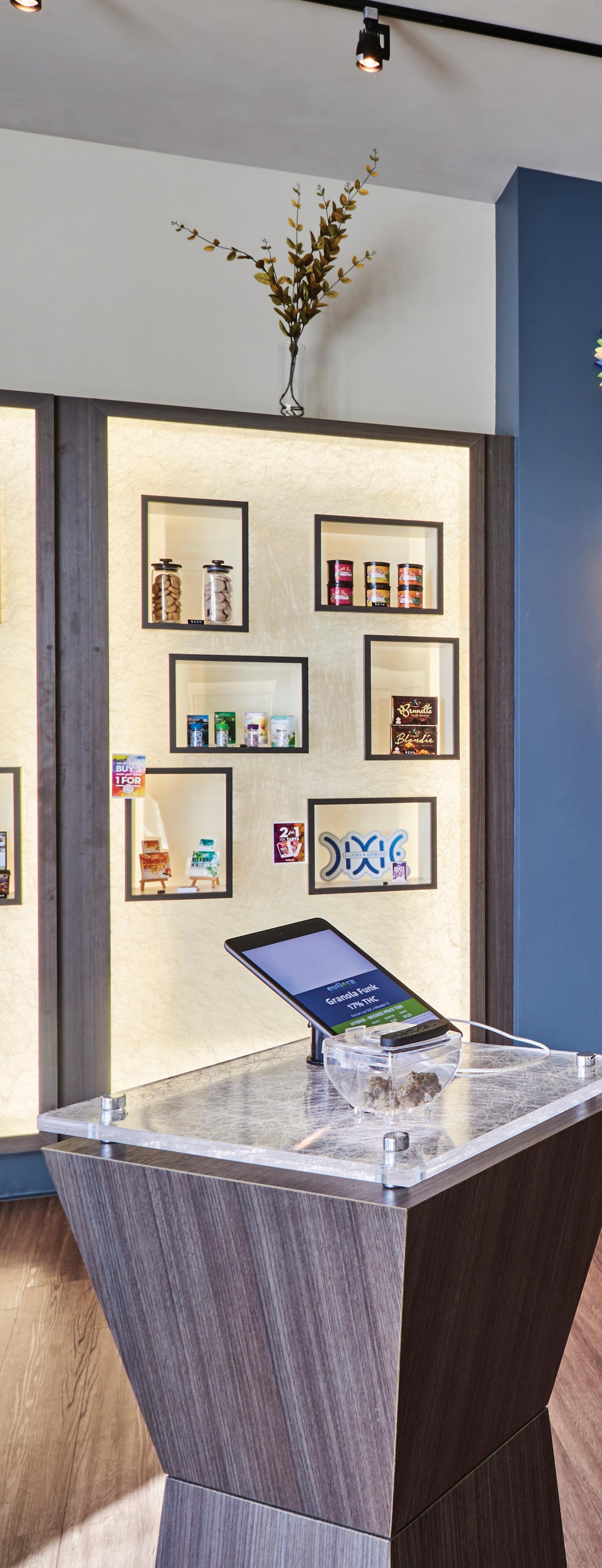
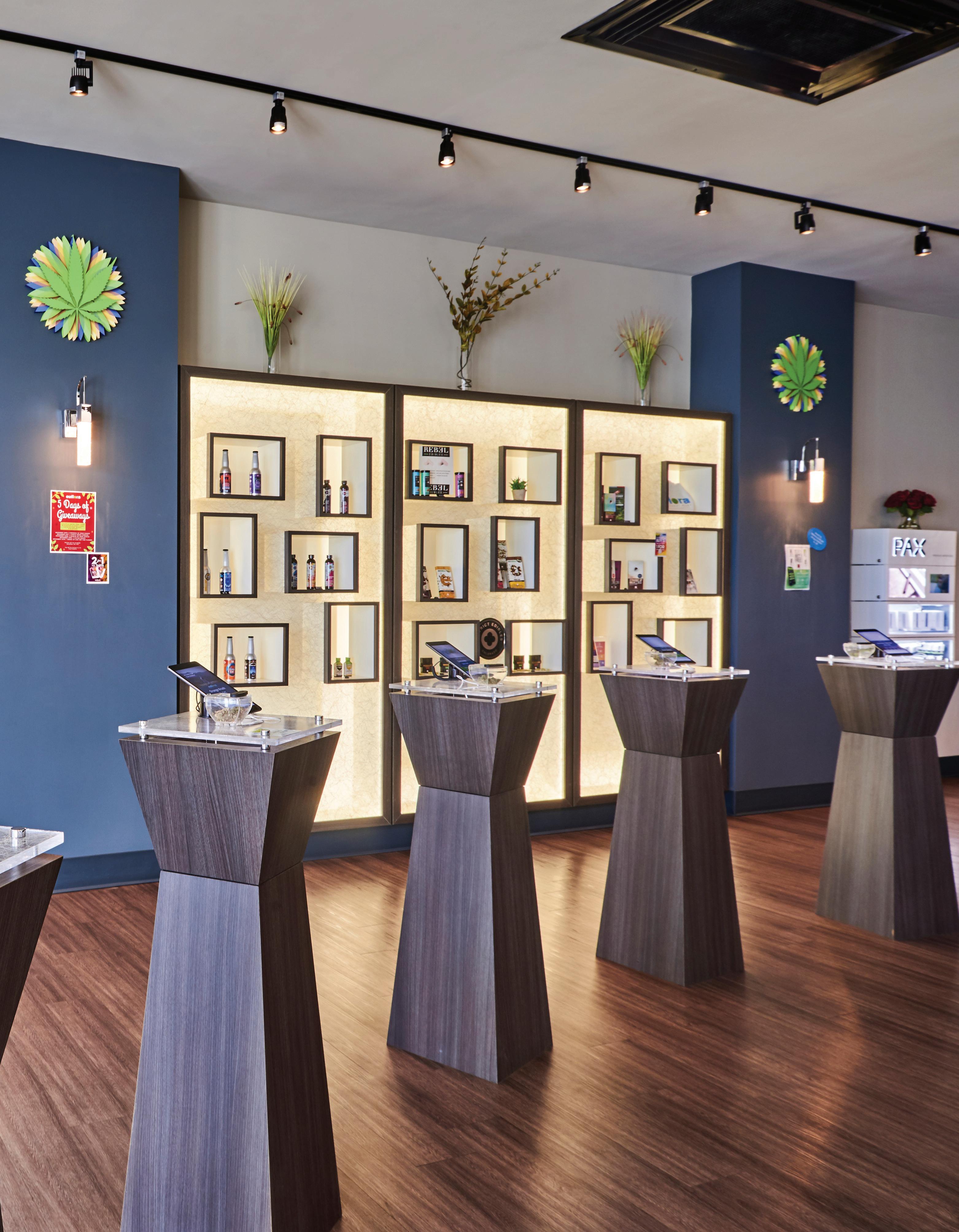
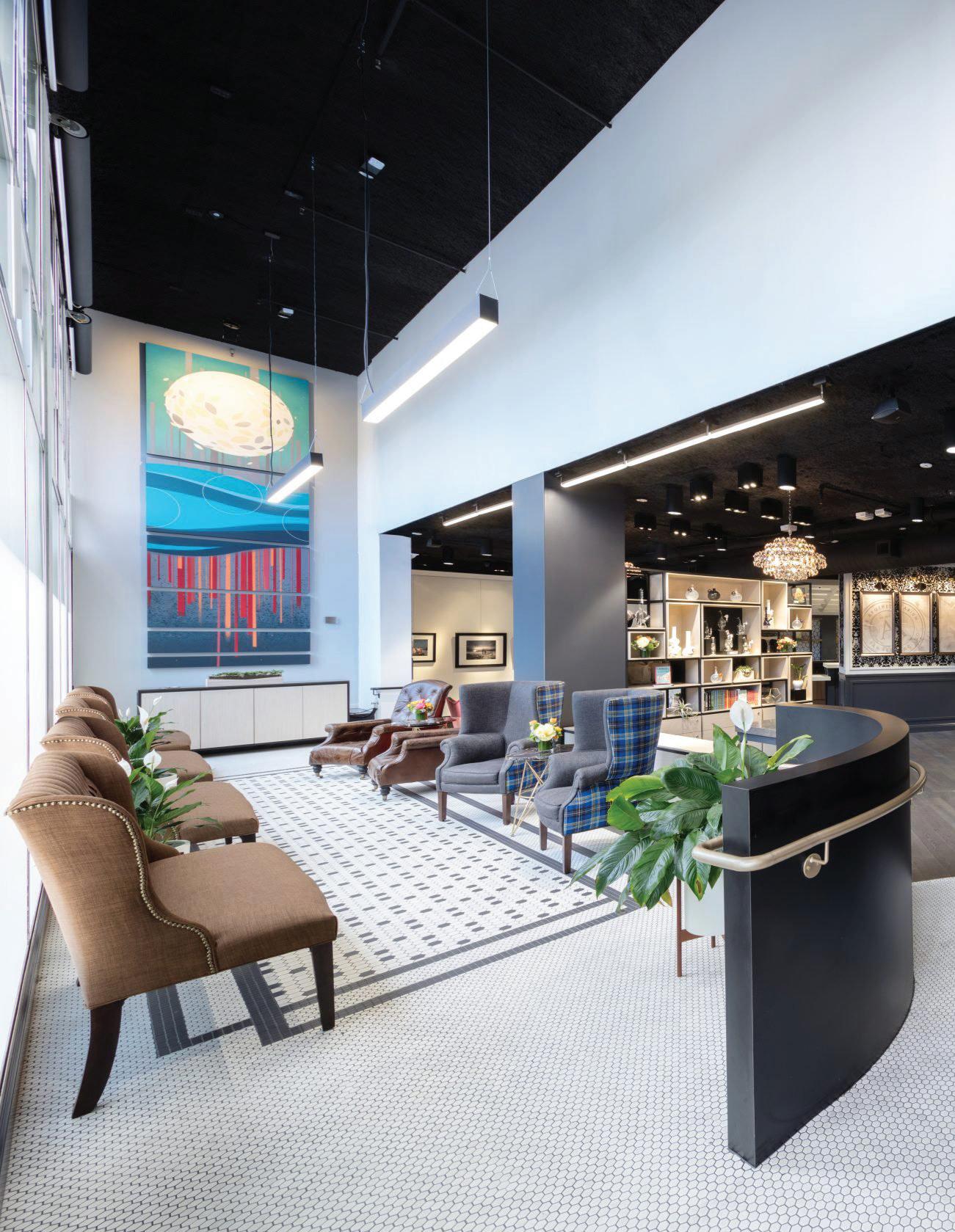
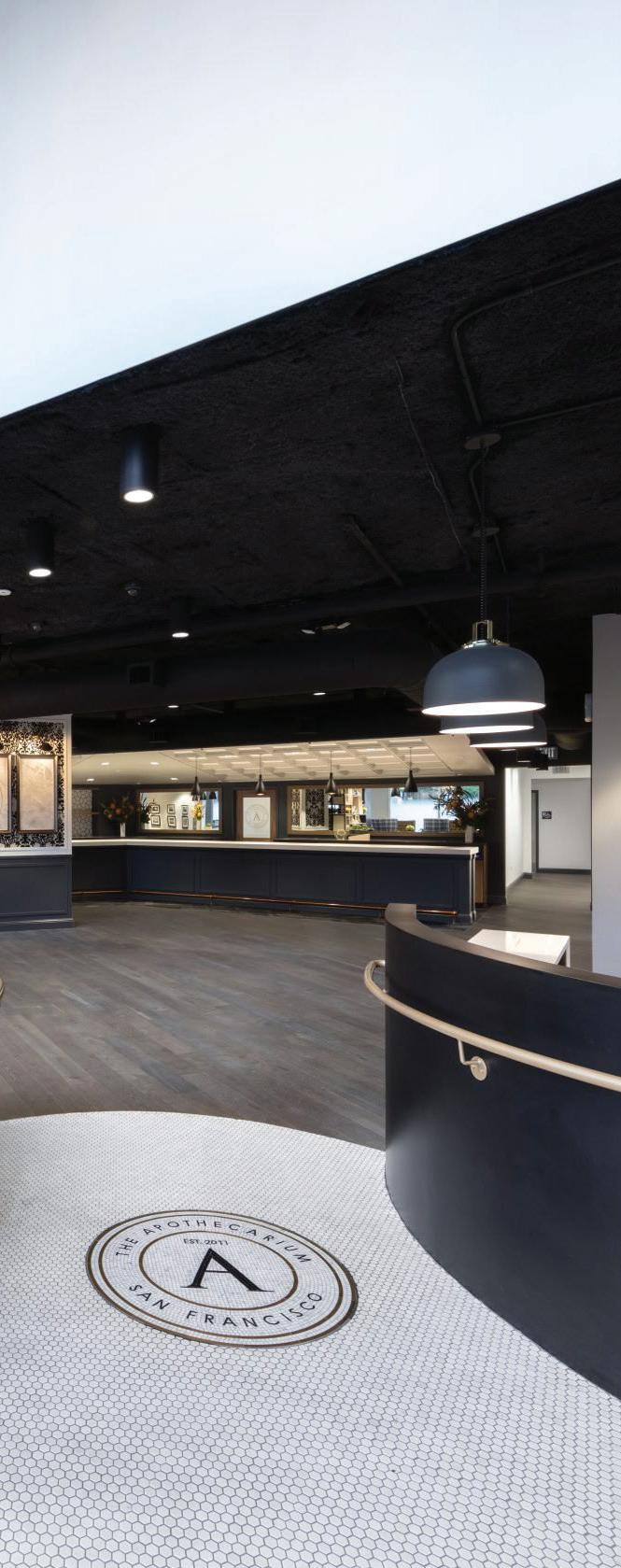
Offer the opportunity to linger, unwind, and learn.
Saks Fifth Avenue, Harrods, Apple Store
“Give shoppers an opportunity to pause and relax,” Lam said. Devote a comfy corner with a sofa, table, and lamp. Add coffee-table books or magazines for extra interest. “It should almost feel like home.”
Or, as Chan suggested, “you can take advantage of the space for personalized consultations for high-value customers seeking a curated experience. You want them to feel appreciated.”
But remember: When choosing a cozy space’s décor, let customers and their preferences guide the look and feel, and be ready for the space to evolve. “It’s not about you. It’s about them,” Walker said.
Or mimic Apple’s Genius Bar, he suggested. Customers who seek repairs for a broken phone or laptop may sit at a counter and wait while browsing products and educational materials on an iPad. The tactic sparks curiosity and desire. High-end clothing boutiques and furniture stores offer the same sort of “browse while you wait in comfort” approach.
“When you put similar spaces in the cannabis world, sales can grow by leaps and bounds,” Walker said. “Some customers can use digital screens, while others can learn on their own or with a budtender’s help.”
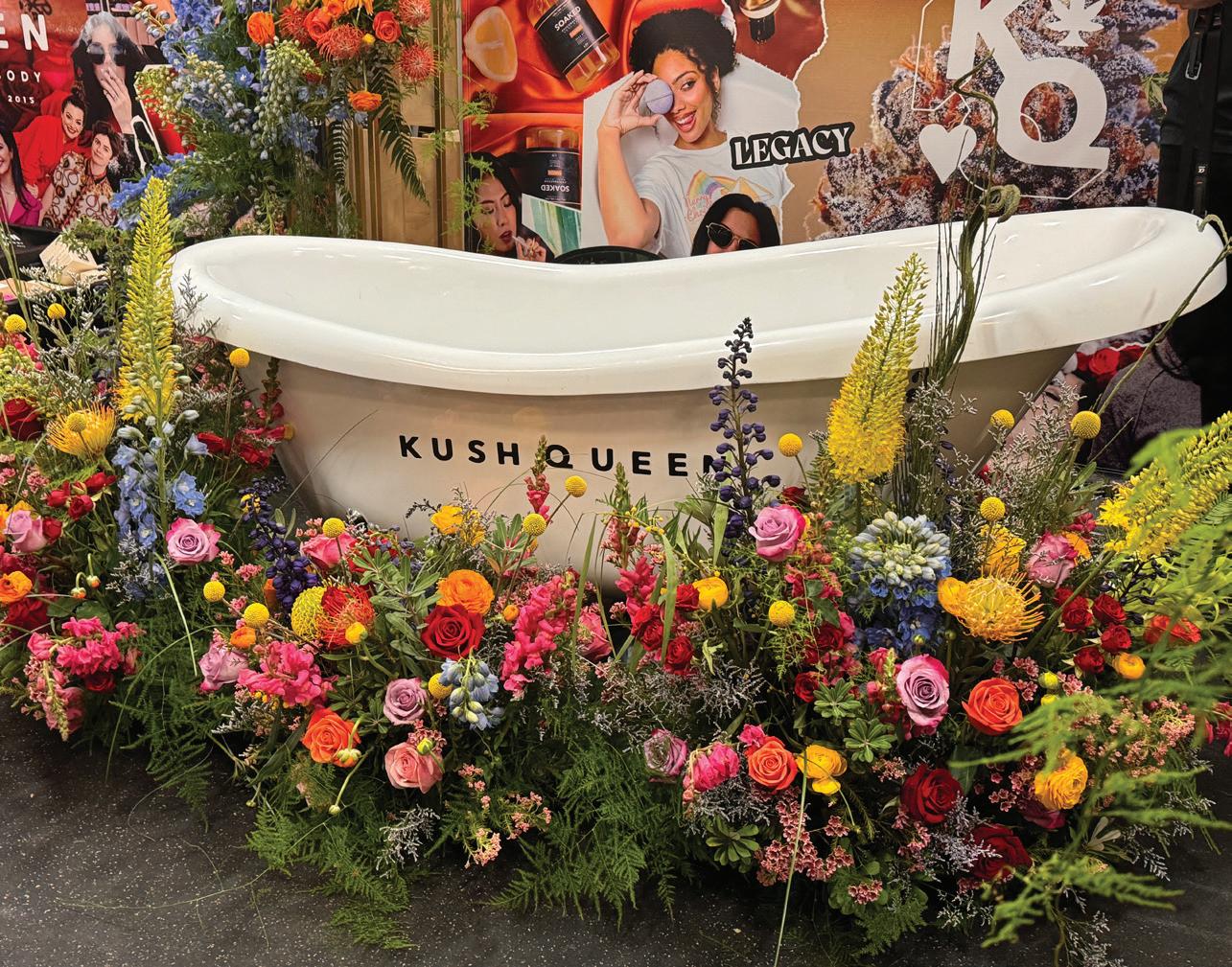
Hall of Flowers produces highly curated business-to-business trade shows designed to connect licensed brands with retailers and industry professionals. The events emphasize product discovery, relationship building, and elevating the retail experience. Each Hall of Flowers show features immersive brand activations, onsite ordering, and a thoughtfully designed environment tailored for deal-making.
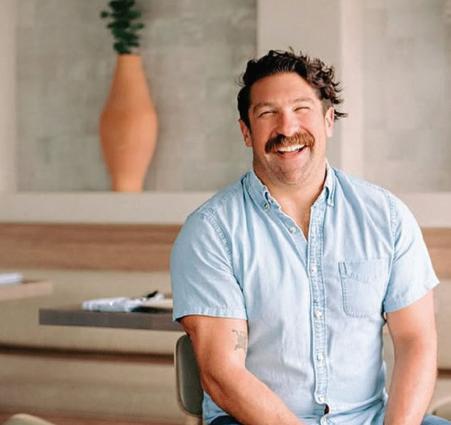


Led by founder Eli Hariton, Damn Good Interiors transforms ordinary spaces into bold, adventurous environments that foster connection and self-expression. The fi rm’s collaborative approach ensures each design reflects the client's unique personality, creating memorable spaces that invite togetherness.

RDC, an architecture fi rm based in Long Beach, California, specializes in creating innovative dispensary designs that prioritize customer experience and community integration. The fi rm’s adaptive reuse approach transforms existing structures into inviting retail spaces, exemplifi ed by awardwinning projects like The Set.
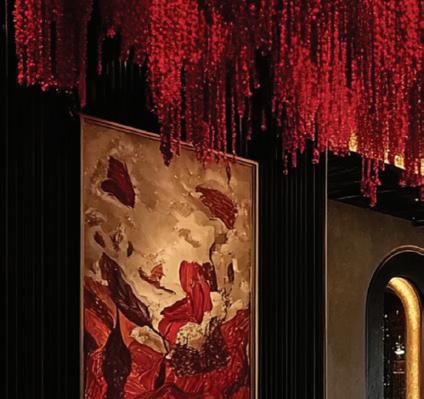
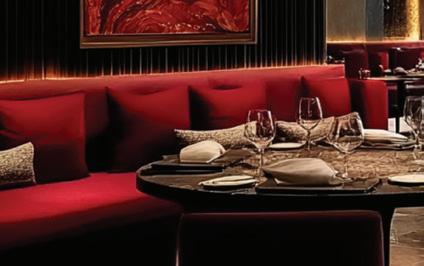



Designer Pria Rajput leverages her architectural background to create innovative interiors. Her global portfolio, spanning work from New York to Dubai, displays unique environments that blend form and function to create elegant, immersive spaces that reflect both individuality and intention.

21k
protect sensitive information and reputations. ADR methods are typically informal and solution-focused, fostering mutual understanding and often allowing for a resolution with


Journey through the extensive photography archive of mg Magazine with this unique collection of images, each telling a story of resilience and ambition.
Moments: Chronicles of Success celebrates the sacrifice, dedication, and perseverance of the individuals who have shaped today’s cannabis industry, offering inspiration for generations to come. Order Today: mgmagazine.com/moments
